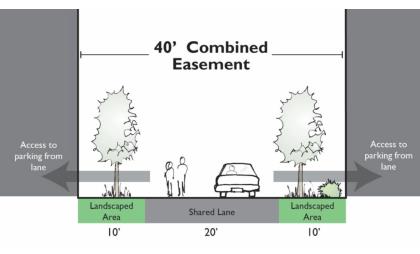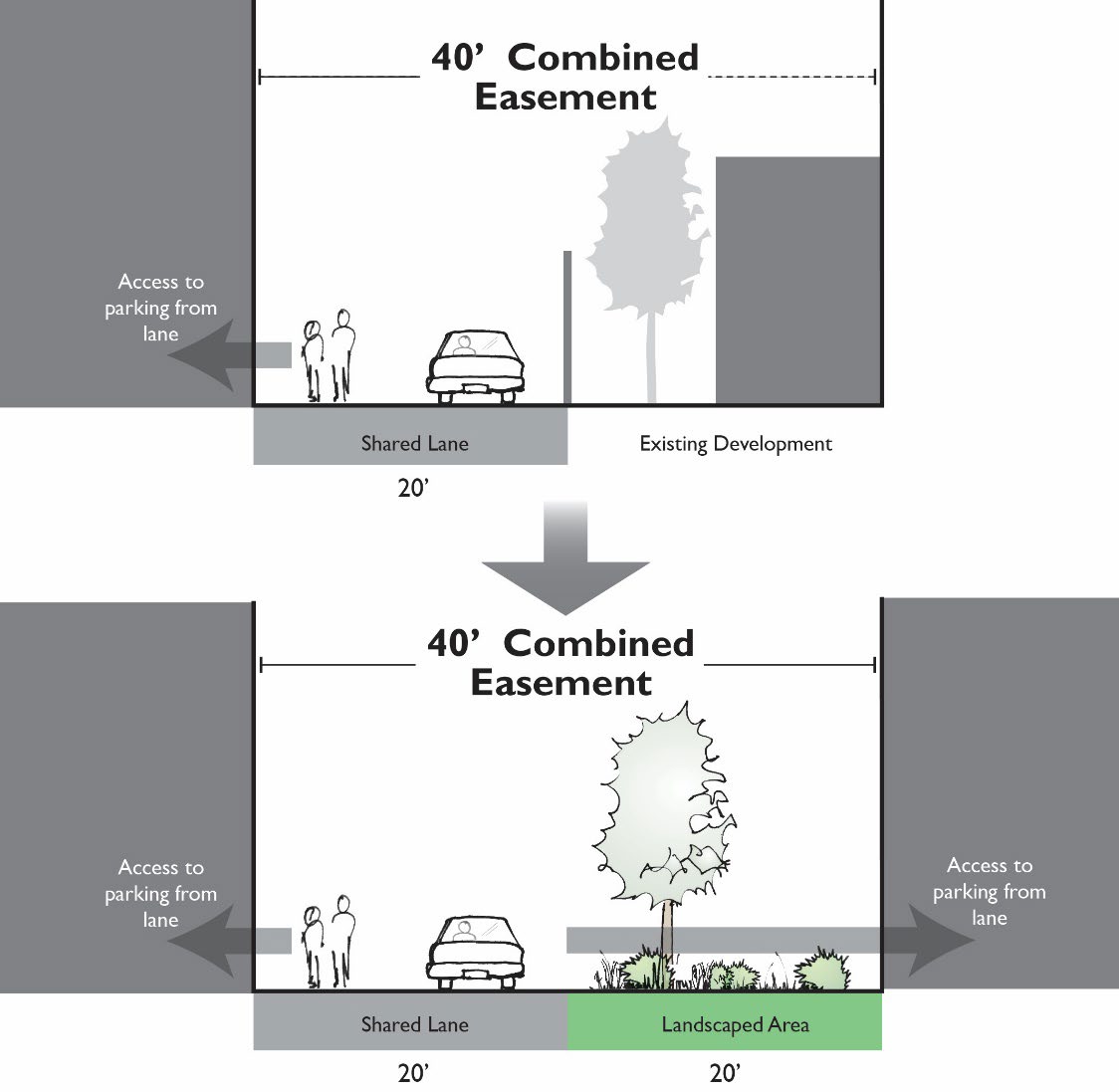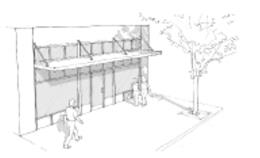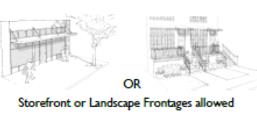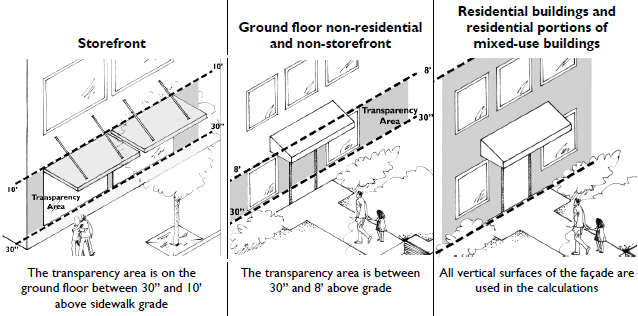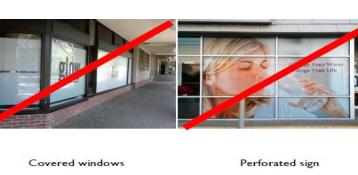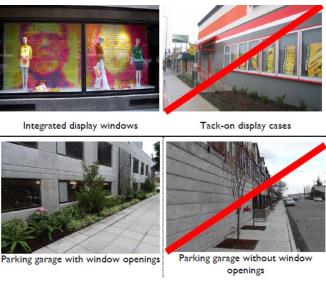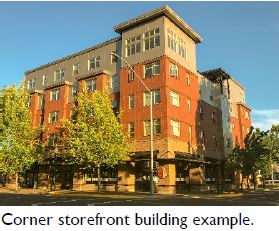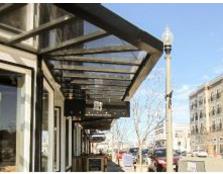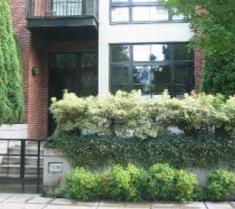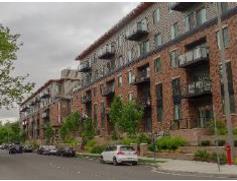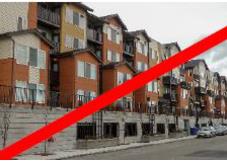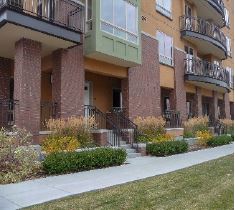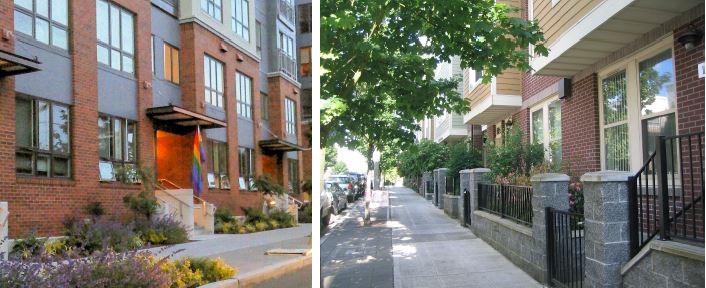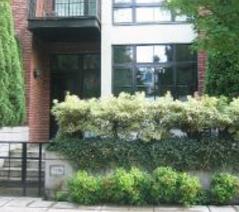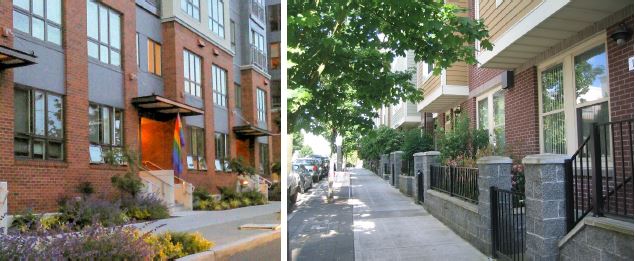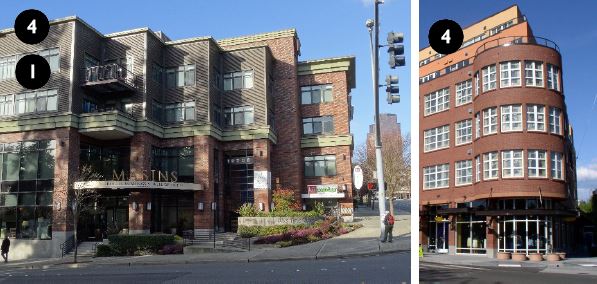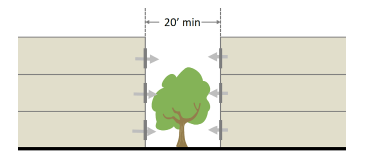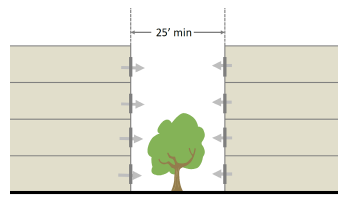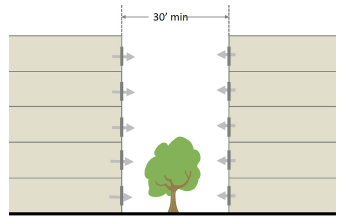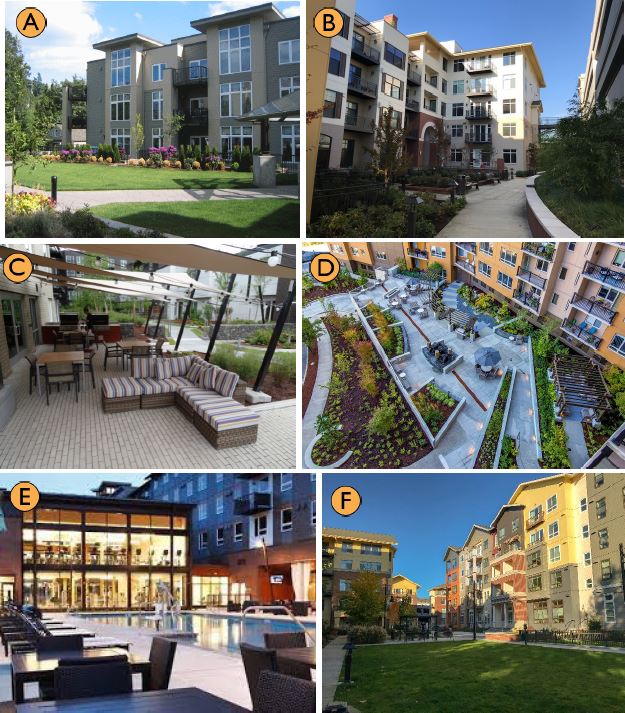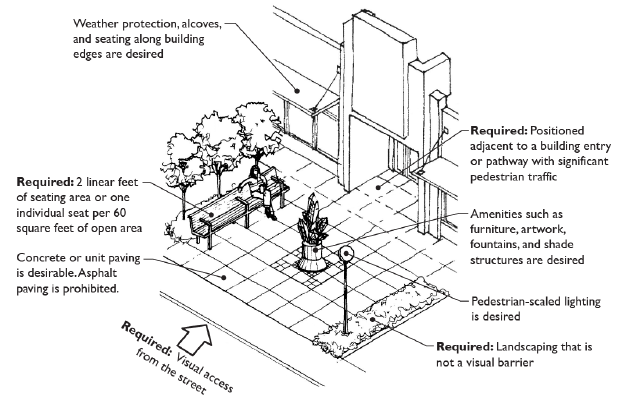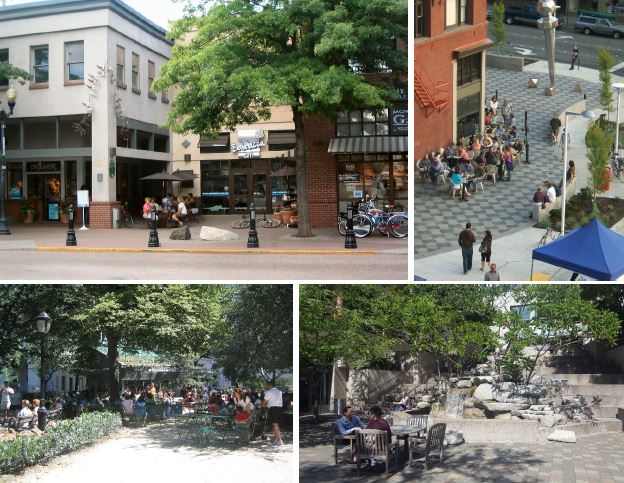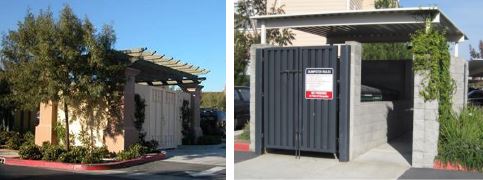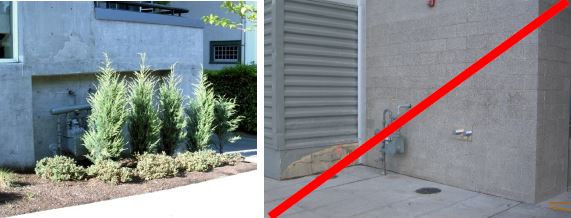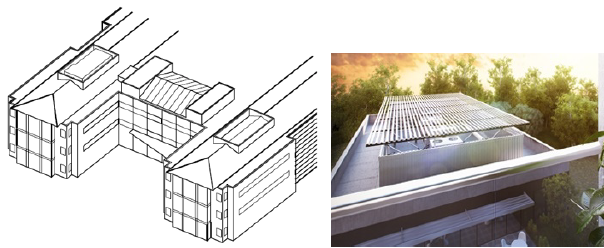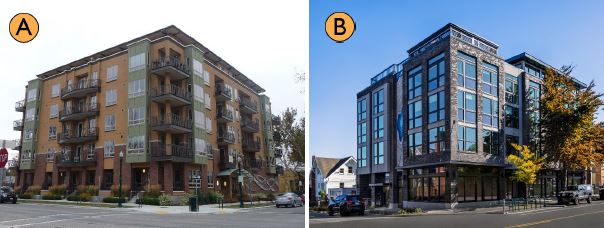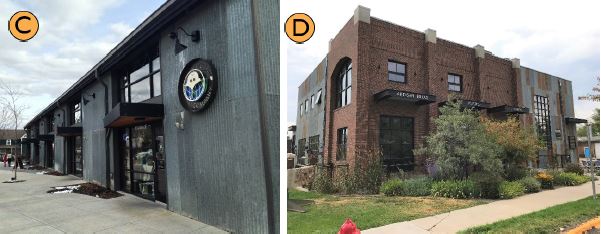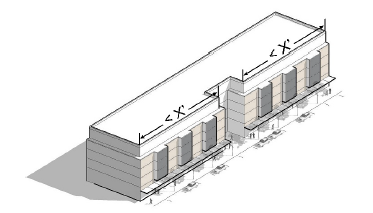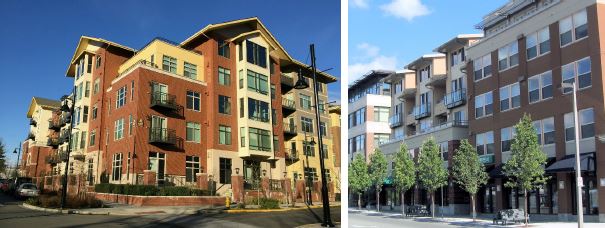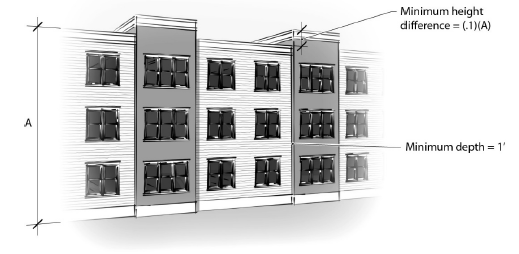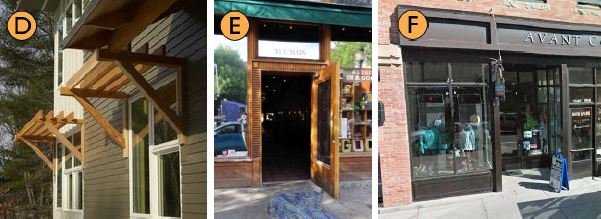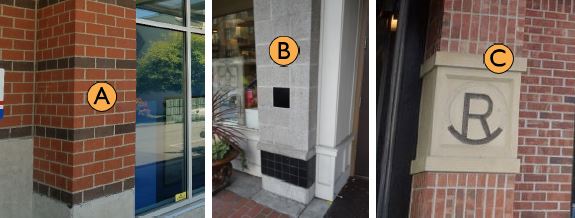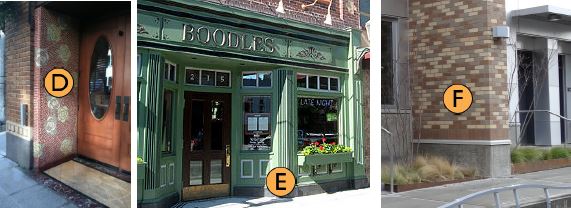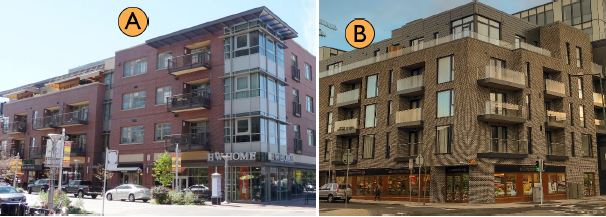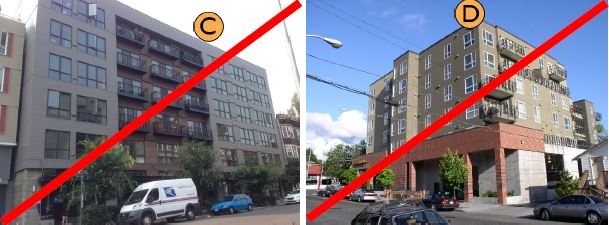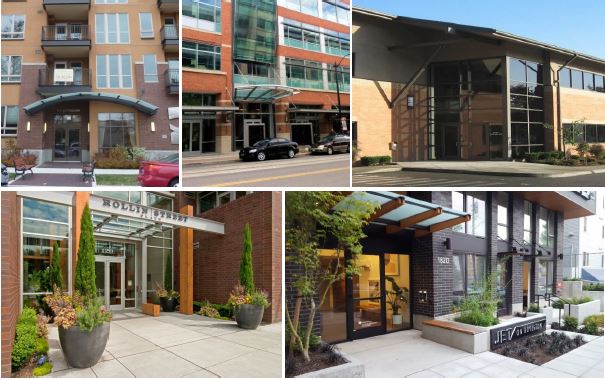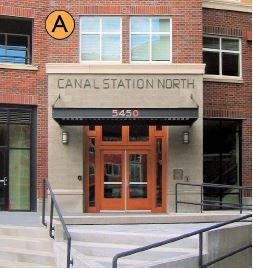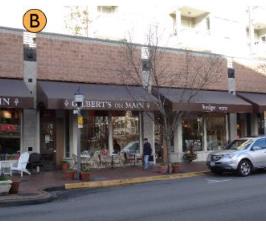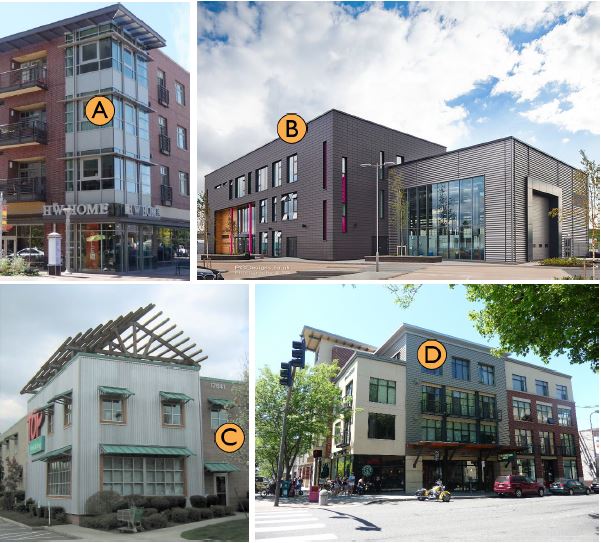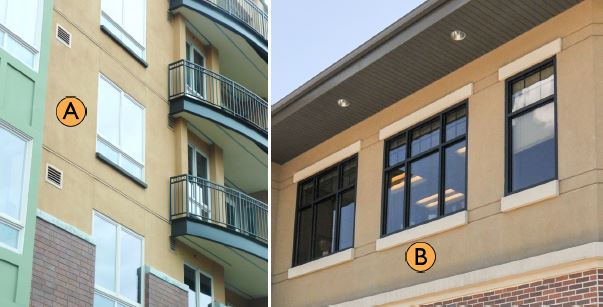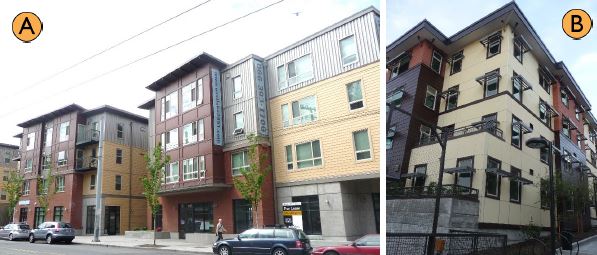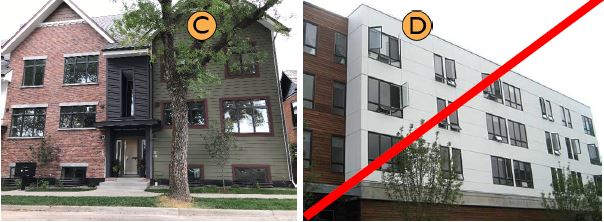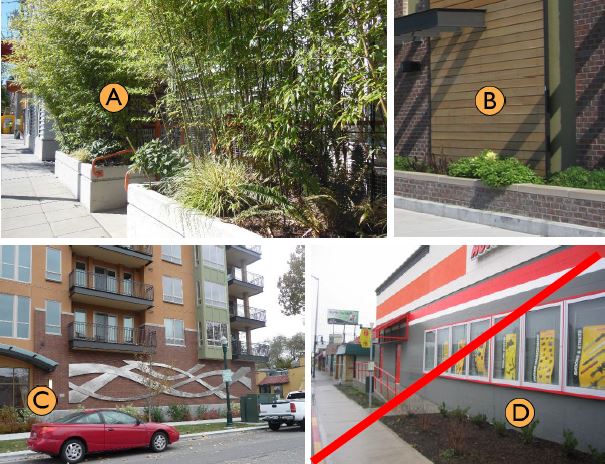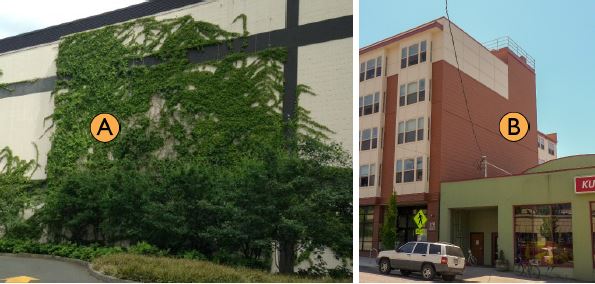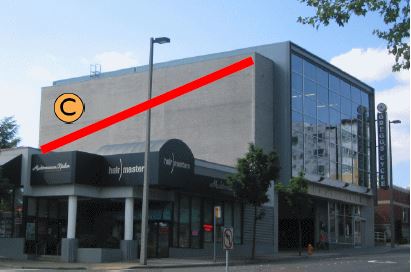Chapter 22C.080
DOWNTOWN MASTER PLAN AREA – DESIGN REQUIREMENTS
Sections:
Article I. Purpose and Applicability
22C.080.020 How the provisions of this chapter are applied.
22C.080.040 Relationship to other codes.
Article II. Zoning
22C.080.105 Marysville downtown subarea zoning classifications.
22C.080.120 Uses permitted in downtown Marysville zones.
22C.080.130 Opiate substitution treatment program facilities.
22C.080.140 Dimensional regulations for downtown Marysville zones.
22C.080.150 Side and rear yard setbacks.
Article III. Street Design, Circulation and Parking
22C.080.210 Streetscape classifications and regulations.
22C.080.220 Through-block connections.
22C.080.230 Parking and loading.
Article IV. Design Standards – Block Frontages
22C.080.305 Block frontage designation map.
22C.080.310 Transparency standards.
22C.080.320 Active ground floor block frontage standards.
22C.080.330 Landscaped block-frontage standards.
22C.080.340 Pedestrian-friendly block frontage standards.
22C.080.350 Undesignated (streets with no designated block frontage).
22C.080.355 Woonerf and landscaped passageway frontage standards.
22C.080.360 Urban passage frontage standards.
22C.080.370 Where properties front onto multiple streets.
22C.080.380 High-visibility street corners.
Article V. Design Standards – Site Planning
22C.080.410 On-site open space and recreation space.
22C.080.420 Pedestrian-oriented spaces.
22C.080.430 Internal pedestrian access and design.
22C.080.440 Service areas and mechanical equipment.
Article VI. Design Standards – Building Design
22C.080.505 Third Street character area.
22C.080.510 Building massing and articulation.
22C.080.530 Building materials.
22C.080.540 Blank wall treatment.
Article I. Purpose and Applicability
22C.080.000 Purpose.
The purpose of this chapter is to help implement the vision for downtown Marysville as provided in the adopted Marysville downtown master plan. (Ord. 3295 § 10 (Exh. J), 2023; Ord. 3191 § 6 (Exh. B), 2021).
22C.080.010 Applicability.
(1) New Construction. This chapter will be used to evaluate development projects or improvement plans proposed for properties within the Marysville downtown boundaries, including the zoning classifications listed in MMC 22C.080.105 and mapped in Figure 22C.080.110.
(2) Additions and Improvements. Three different thresholds have been established to determine how the regulations herein are applied to such projects.
(a) Level I improvements include all exterior remodels, building additions, and/or site improvements that affect the exterior appearance of the building/site, and/or cumulatively increase the gross floor area on a site less than 50 percent within three years of the date of permit issuance. The requirement for such improvements is only that the proposed improvements meet the regulations and do not lead to further nonconformance with the regulations.
For example, if a property owner decides to replace a building facade’s siding, then the siding shall meet the applicable exterior building material regulations, but elements such as building articulation would not be required.
(b) Level II improvements include all improvements that cumulatively increase the gross floor area on a site by 50 to 100 percent, within three years of the date of permit issuance. All regulations that do not involve repositioning the building or reconfiguring site development shall apply to Level II improvements.
For example, if a property owner of an existing business in the DC zone wants to build an addition equaling 75 percent of the current building’s footprint, then the following elements shall apply:
(i) The location and design of the addition/remodel shall be consistent with the block frontage design regulations (see Article IV of this chapter, which addresses building frontages, entries, parking lot location, and street setback landscaping). For such developments seeking additions to buildings where off-street parking location currently does not comply with applicable parking location regulations, building additions are allowed provided they do not increase any current nonconformity and generally bring the project closer into conformance with the regulations.
(ii) Comply with applicable through-block connection, trail, and off-street parking regulations (see Article III of this chapter) that are associated with the addition. The through-block connection provisions would apply where such addition is located in the immediate area of such features shown in Figure 22C.080.220.A.
(iii) Comply with applicable block frontage regulations (see Article IV of this chapter) that are associated with the addition. The block frontage provisions would apply when such an addition is located adjacent to a particular designated block frontage shown in Figure 22C.080.305.
(iv) Comply with the site planning design regulations (see Article V of this chapter) associated with proposed site and building improvements.
(v) Comply with the applicable building design regulations (see Article VI of this chapter), except architectural scale and materials provisions related to the existing portion of the building where no exterior changes are proposed.
(c) Level III improvements include all improvements that cumulatively increase the gross floor area on a site by more than 100 percent within three years of the date of permit issuance. Such developments shall conform to all applicable regulations, except in a case where there are multiple buildings on one site, and only one building is being enlarged. In that scenario, improvements to the additional buildings are not required, but conformance with all other regulations apply. (Ord. 3295 § 10 (Exh. J), 2023; Ord. 3191 § 6 (Exh. B), 2021).
22C.080.020 How the provisions of this chapter are applied.
Most sections within this chapter include the following elements:
(1) Purpose statements, which are overarching objectives.
(2) Requirements use words such as “shall” and “is/are required,” signifying required actions.
(3) Guidelines use words such as “should” or “is/are recommended,” signifying desired, but voluntary, measures.
(4) Departures are provided for specific regulations. They allow alternative designs provided the director determines the design meets the purpose of the requirements and guidelines and other applicable criteria. See MMC 22C.080.030 for related procedures associated with departures.
(5) This chapter contains some specific regulations that are easily quantifiable, while others provide a level of discretion in how they are complied with. In the latter case, the applicant shall demonstrate to the director, in writing, how the project meets the purpose of the standard or regulations. (Ord. 3295 § 10 (Exh. J), 2023; Ord. 3191 § 6 (Exh. B), 2021).
22C.080.030 Departures.
(1) Overview and Purpose. This chapter provides for a number of specific departure opportunities to development regulations. The purpose is to provide applicants with the option of proposing alternative design treatments provided such departures meet the “purpose/intent” of the particular regulation and any additional departure criteria established for the particular departure opportunity.
(2) Applicability. Departure opportunities are available only where noted for specific regulations, including those standards that precede the “➲” symbol or capital letter “DEPARTURE” reference.
(3) Procedures. Permit applications that include departure requests go through the standard review procedures in this chapter for the application type.
(4) Approval Criteria. Project applicants shall successfully demonstrate to the director how the proposed departure meets the purpose(s) of the regulation and other applicable departure criteria that applies to the specific regulation.
(5) Documentation. The director shall document the reasons for approving all departures (to be maintained with project application records) to ensure consistency in decision-making by the city. (Ord. 3295 § 10 (Exh. J), 2023; Ord. 3191 § 6 (Exh. B), 2021).
22C.080.040 Relationship to other codes.
Where provisions of this chapter conflict with provisions in any other section of the Marysville Municipal Code (MMC), this chapter prevails unless otherwise noted. (Ord. 3295 § 10 (Exh. J), 2023; Ord. 3191 § 6 (Exh. B), 2021).
Article II. Zoning
22C.080.100 Purpose.
The purpose of Article II is to:
(1) Implement the Marysville downtown master plan goals and policies through land use regulations.
(2) Provide an efficient and compatible relationship of land uses and zones. (Ord. 3295 § 10 (Exh. J), 2023; Ord. 3191 § 6 (Exh. B), 2021).
22C.080.105 Marysville downtown subarea zoning classifications.
The downtown Marysville subarea regulations in this chapter comprise zoning classifications and regulations which are unique to the subarea, except where other regulations in this title are adopted by reference.
|
Name of Downtown Marysville Zoning Districts |
Symbol |
|
Downtown Core |
DC |
|
Main Street |
MS |
|
Flex |
F |
|
Flex Residential |
FR |
|
Midrise Multifamily |
MMF |
|
Middle Housing 1 |
MH1 |
|
Middle Housing 2 |
MH2 |
(1) Downtown Core (DC). The downtown core zone encourages high density residential mixed use and office mixed use. Other commercial uses and multifamily residential are allowed. No active ground floor required except on designated streets.
(2) Main Street (MS). The Main Street zone protects and enhances the character of Marysville’s historic retail core. This zone encourages high-activity uses like restaurants, entertainment, and shops, and residential above the ground floor. New buildings should feature an active ground floor use. Parking is not required for some uses in small commercial buildings.
(3) Flex (F). This zone encourages a mix of uses, including artisan, workshops, small light industrial/manufacturing (indoors), and commercial. New residential, schools, daycares, and other sensitive uses are not allowed due to air quality, noise, and odor impacts from I-5 and the BNSF railroad corridor.
(4) Flex Residential (FR). This zone encourages a mix of uses including artisan, workshops, small light industrial/manufacturing (indoors), commercial, and allows “missing middle” housing and low-rise apartments.
(5) Midrise Multifamily (MMF). This zone encourages dense multifamily housing. Small commercial uses are allowed for properties abutting Third and Fourth Streets, but are limited to a ground floor element of a mixed use building for other properties within this zone.
(6) Middle Housing 1 (MH1). This zone encourages small infill housing, especially “missing middle” housing. The zone protects the fine-grained, residential character of historic neighborhoods.
(7) Middle Housing 2 (MH2). This zone encourages infill housing, especially “missing middle” housing and low-rise apartments. Commercial is not allowed except as a ground floor element of a mixed use building located along an arterial street, and is limited to uses that serve the immediate needs of the neighborhood. (Ord. 3295 § 10 (Exh. J), 2023; Ord. 3191 § 6 (Exh. B), 2021).
22C.080.110 Districts map.
Figure 22C.080.110 illustrates the location and boundaries of downtown’s zones for reference.
Figure 22C.080.110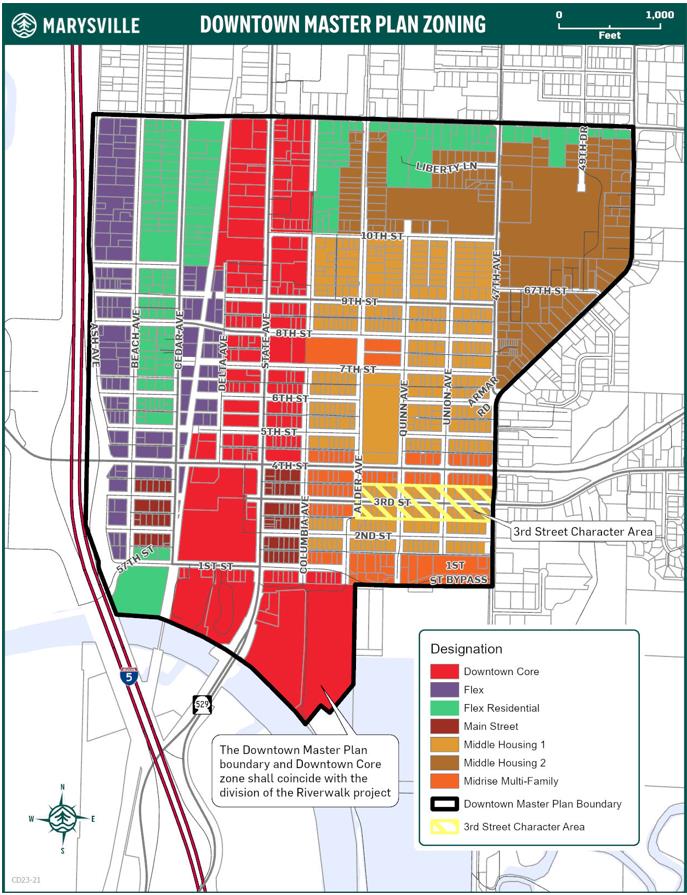
(Ord. 3295 § 10 (Exh. J), 2023; Ord. 3191 § 6 (Exh. B), 2021).
22C.080.120 Uses permitted in downtown Marysville zones.
(1) Interpretation of Permitted Use Table. The permitted use table in this section determines whether a use is allowed in a zone. The name of the zone is located on the vertical column and the use is located on the horizontal row of these tables.
(a) Permitted Use (P). If the letter “P” appears in the box at the intersection of the column and the row, the use is permitted in the zone. These uses are allowed if they comply with the development standards and other standards of this chapter.
(b) Conditional Use (C). If the letter “C” appears in the box at the intersection of the column and the row, the use is allowed subject to the conditional use review process and approval criteria as stated in Chapter 22G.010 MMC, conditional use approval criteria for that use, the development standards and other standards of this chapter.
(c) Use Not Permitted ( ). Where no symbol appears in the box at the intersection of the column and the row, the use is not permitted in that zone, except for certain temporary uses.
(d) For uses containing a superscript letter (X), refer to the applicable condition in the “Additional Provisions” column to the right.
(e) Additional Provisions. The references, notes, and/or standards in the “Additional Provisions” column apply to all such permitted uses, except for those that apply to particular zones as noted in subsection (1)(d) of this section.
(f) For uses containing a superscript letter (Y) or (Z), refer to the “Notes” that are at the top of the “Nonresidential Uses” section.
(g) Unclassified Uses. See MMC 22A.010.070.
(2) Permitted Use Table. Table 22C.080.120 provides the list of permitted uses in downtown Marysville zones.
|
Table legend: P = Permitted use C = Conditional use No letter = Use not permitted Use Categories |
DC |
MS |
F |
FR |
MMFY |
MH1 |
MH2Z |
Additional Provisions |
|---|---|---|---|---|---|---|---|---|
|
Residential Uses |
||||||||
|
Dwelling Units, Types |
||||||||
|
Note: Residential uses are not allowed on the ground floor facing a designated active ground floor block frontage (see MMC 22C.080.320). Lobbies for multifamily uses and live-work dwelling units are an exception, provided the units meet the standards in MMC 22C.080.320. |
||||||||
|
Single detached |
|
|
|
|
|
|
|
Single detached dwellings are limited to those established on or prior to September 27, 2021, and are subject to the provisions of Chapter 22C.100 MMC, Nonconforming Situations. |
|
Duplex |
|
|
|
P |
P |
P |
P |
|
|
Townhouse |
P |
P |
|
P |
P |
P |
P |
|
|
Multifamily |
P |
PX |
|
P |
P |
|
P |
X Multifamily must be above a ground floor commercial use in the MS zone. |
|
Senior citizen assisted |
P |
|
|
C |
P |
C |
C |
|
|
Group Residences |
||||||||
|
Adult family home |
P |
P |
P |
P |
P |
P |
P |
Permitted within a single detached dwelling in existence as of September 27, 2021 Use is subject to obtaining a state license in accordance with Chapter 70.128 RCW |
|
Home, rest, convalescent, or for the aged |
P |
|
|
|
P |
|
|
|
|
Residential care facilities |
P |
P |
P |
P |
P |
P |
P |
|
|
Enhanced services facilities |
P |
|
P |
P |
|
|
|
Enhanced services facilities are limited to the areas depicted in MMC 22C.280.050, Figure 1 In the DC zone, enhanced services facilities shall be located above a permitted ground floor commercial use See Chapter 22C.280 MMC for enhanced services facility regulations |
|
Transitional housing facilities |
P |
P |
P |
P |
P |
P |
P |
Provide an operations plan as outlined in MMC 22C.010.070(53) and 22C.020.070(79) |
|
Permanent supportive housing |
P |
P |
P |
P |
P |
P |
P |
Provide an operations plan as outlined in MMC 22C.010.070(53) and 22C.020.070(79) |
|
Emergency housing |
P, C |
P, C |
P, C |
P, C |
|
|
|
All facilities are subject to the regulations set forth in Chapter 22C.290 MMC, Emergency Housing and Shelters. Facilities with 30 or more residents require a conditional use permit |
|
Emergency shelters – indoor |
P, C |
P, C |
P, C |
P, C |
|
|
|
All facilities are subject to the regulations set forth in Chapter 22C.290 MMC, Emergency Housing and Shelters. Facilities with 30 or more residents require a conditional use permit |
|
Residential Accessory Uses |
||||||||
|
Dwelling units, accessory |
|
|
|
|
|
P |
P |
MMC 22C.180.030 |
|
Home occupations |
P |
P |
P |
P |
P |
P |
P |
Chapter 22C.190 MMC No signage is permitted in townhouse or multifamily buildings |
|
Other residential accessory uses |
P |
P |
P |
P |
P |
P |
P |
Uses accessory to permitted principal uses may be pursued as authorized by the director |
|
Nonresidential Uses |
||||||||
|
Notes: Y In the midrise multifamily (MMF) zone, commercial is allowed for properties abutting Third and Fourth Streets, but is limited to a ground floor element of a mixed use building for other properties within this zone. Z In the middle housing 2 (MH2) zone, commercial is not allowed except as a ground floor element of a mixed use building located along an arterial street, and is limited to uses that serve the immediate needs of the neighborhood. |
||||||||
|
Amusement and entertainment |
P |
PX |
P |
P |
|
|
|
Operations shall be conducted entirely indoors X Excludes shooting ranges |
|
Cultural, as listed below based on gross floor area (GFA): |
|
|
|
|
|
|
|
|
|
<10,000 sf GFA |
P |
P |
P |
P |
C |
C |
C |
|
|
10,000 – 20,000 sf GFA |
P |
C |
P |
P |
C |
|
C |
|
|
>20,000 sf GFA |
P |
|
P |
P |
C |
|
|
|
|
Dancing, music and art center |
P |
CX |
P |
P |
|
|
|
X Use conditionally permitted with 10,000 – 20,000 sf GFA and prohibited over 20,000 sf GFA |
|
Day care, as listed below: |
|
|
|
|
|
|
|
Day cares are defined in MMC 22A.020.050 and are subject to all state licensing requirements. X Only as an accessory to residential use and subject to the criteria set forth in Chapter 22C.200 MMC |
|
Day care I |
PX |
PX |
PX |
PX |
PX |
PX |
PX |
|
|
Day care II |
P |
P |
|
C |
C |
|
C |
|
|
Drive-through, principal or accessory |
|
|
|
|
|
|
|
Drive-through is defined in MMC 22A.020.050 |
|
Education services |
P |
P |
P |
P |
C |
C |
C |
|
|
Electric vehicular charging station |
P |
P |
P |
P |
P |
P |
P |
|
|
Electric vehicular battery exchange |
|
|
P |
P |
|
|
|
|
|
Essential public facilities |
C |
C |
C |
C |
C |
C |
C |
See Chapter 22G.070 MMC for the siting process for essential public facilities |
|
General service uses, except those listed below: |
P |
P |
P |
P |
|
|
|
Operations shall be conducted entirely indoors |
|
Small boat sales, rental and repair, equipment rentals, vehicle repair, commercial vehicle repair, car wash, self-storage |
|
|
|
|
|
|
|
|
|
Government services, except as listed below: |
P |
P |
P |
P |
P |
P |
P |
|
|
Public safety facilities, including police and fire |
C |
C |
C |
C |
C |
C |
C |
All buildings shall maintain a 20-foot setback from adjoining residential zones Any buildings from which firefighting equipment emerges onto a street shall maintain a distance of 35 feet from such street |
|
Health services, except as listed below: |
P |
P |
P |
P |
P |
|
|
|
|
Hospital |
C |
|
C |
C |
|
|
|
Pick-up and drop-off areas are permitted if determined by the director to be needed for safe and efficient hospital operations and may be subject to a screening plan. |
|
Heavy service uses, except those listed below: |
|
|
C |
|
|
|
|
|
|
Commercial vehicle storage, automotive rental and leasing |
|
|
|
|
|
|
|
|
|
Light industrial/ manufacturing |
P |
|
P |
|
|
|
|
Operations shall be conducted entirely indoors |
|
Artisan manufacturing |
P |
P |
P |
P |
|
|
|
Operations shall be conducted entirely indoors |
|
Nursery |
PX |
|
P |
P |
|
|
|
X Retail only |
|
Park, community center |
P |
P |
P |
P |
P |
P |
P |
|
|
Parking lot |
P |
|
P |
|
|
|
|
Stand-alone parking lots are only allowed in the listed zones. Parking lots accessory to a residential or nonresidential use are permitted in all zones. |
|
Personal services use |
P |
P |
P |
P |
|
|
|
Operations shall be conducted entirely indoors |
|
Professional office |
P |
P |
P |
P |
P |
|
|
|
|
Marina, dock and boathouse – private and noncommercial, boat launch |
P |
|
P |
P |
|
|
|
|
|
Retail uses, as listed below and based on gross floor area (GFA)/individual use: |
|
|
|
|
|
|
|
Excludes retail uses with exterior sales and/or storage areas. Drive-throughs are prohibited |
|
<2,500 sf GFA |
P |
P |
P |
P |
P |
|
C |
|
|
2,500 – 20,000 sf GFA |
P |
P |
P |
P |
|
|
|
|
|
20,001 – 50,000 sf GFA |
P |
C |
P |
P |
|
|
|
|
|
>50,000 sf GFA |
P |
C |
P |
P |
|
|
|
|
|
Special retail sales uses: |
|
|
|
|
|
|
|
|
|
Eating and drinking places |
P |
P |
P |
P |
C |
|
|
Drive-throughs are prohibited |
|
Gas station |
P |
|
P |
P |
|
|
|
|
|
Heavy retail, except as listed below |
|
|
C |
|
|
|
|
|
|
Motor vehicle and boat dealer, and heavy equipment sales |
|
|
|
|
|
|
|
|
|
State-licensed marijuana facilities |
|
|
|
|
|
|
|
|
|
Temporary lodging |
P |
P |
P |
P |
|
|
|
|
|
Temporary uses |
See Chapter 22C.110 MMC |
|||||||
|
Regional Uses |
||||||||
|
Regional uses, except as listed below: |
|
|
|
|
|
|
|
|
|
College |
P |
|
P |
P |
C |
|
C |
|
|
Transit park and pool lot |
P |
|
P |
P |
P |
|
P |
|
|
Opiate substitution treatment program facilities |
P |
|
P |
P |
|
|
|
MMC 22C.080.150 |
|
Jail |
C |
|
C |
C |
|
|
|
|
|
Regional storm water facility |
C |
|
C |
C |
C |
C |
C |
|
|
Public agency training facility |
C |
|
C |
C |
|
|
|
Except weapons armories and outdoor shooting ranges |
|
Nonhydroelectric generation facility |
C |
|
C |
C |
C |
C |
C |
|
|
Wireless communication facility |
P, C |
P, C |
P, C |
P, C |
P, C |
P, C |
P, C |
Subject to Chapter 22C.250 MMC and the small cell wireless design district provisions in MMC 22C.250.120. |
|
Nonresidential Accessory Uses |
||||||||
|
Nonresidential accessory uses |
P |
P |
P |
P |
P |
P |
P |
Uses accessory to permitted principal uses may be pursued as authorized by the director. |
(Ord. 3295 § 10 (Exh. J), 2023; Ord. 3205 § 7, 2022; Ord. 3196 § 3 (Exh. A), 2021; Ord. 3191 § 6 (Exh. B), 2021).
22C.080.130 Opiate substitution treatment program facilities.
(1) Opiate substitution treatment program facilities permitted within commercial zones are subject to Chapter 22G.070 MMC, Siting Process for Essential Public Facilities.
(2) Opiate substitution treatment program facilities, as defined in MMC 22A.020.160, are subject to the standards set forth below:
(a) Shall not be established within 300 feet of an existing school, public playground, public park, residential housing area, child care facility, or actual place of regular worship established prior to the proposed treatment facility.
(b) Hours of operation shall be restricted to no earlier than 6:00 a.m. and no later than 7:00 p.m. daily.
(c) The owners and operators of the facility shall be required to take positive ongoing measures to preclude loitering in the vicinity of the facility. (Ord. 3295 § 10 (Exh. J), 2023; Ord. 3191 § 6 (Exh. B), 2021. Formerly 22C.080.150).
22C.080.140 Dimensional regulations for downtown Marysville zones.
(1) Purpose. To promote forms of development that reinforce and/or enhance the desired character of the downtown Marysville zones.
(2) Dimensional Regulations Table. The table below addresses the form and intensity of development specific to individual downtown Marysville zones. The zone is located on the vertical columns and the form/intensity measure being addressed is located on the horizontal rows.
|
Measure |
DC |
MS |
F |
FR |
MMF |
MH1 |
MH2 |
Additional Provisions |
|---|---|---|---|---|---|---|---|---|
|
DEVELOPMENT INTENSITY AND HEIGHT |
||||||||
|
Base height (feet) |
85X |
45X |
45X,Y |
45X,Y |
65 |
35 |
45 |
X Height may be increased by 1' for each 1' of street and interior setback beyond minimum requirement Y Max height is 75' for the SW waterfront parcel, as depicted in Map 3 of the Downtown Master Plan |
|
Minimum density (du/acre) |
20 |
|
|
20 |
20 |
10 |
10 |
The director may waive the minimum density requirement for: (a) mixed use projects that provide a wide variety of desirable nonresidential uses; or (b) for sites with unique size, shape, topography, location, critical areas encumbrance, or other feature that precludes the minimum density being achieved. A written justification must be provided by the applicant and is subject to director approval. |
|
Maximum density (du/acre) |
None |
None |
|
None |
None |
None |
None |
|
|
Minimum lot area (square feet) |
There is no minimum lot area regulation; however, lot dimensions will be influenced by permitted uses, market conditions, and other development regulations herein. |
|
||||||
|
Maximum impervious surface (%) |
There is no maximum percentage standard for impervious surfaces; however, the impervious surfaces will be limited by setbacks, required landscaping and open space, compliance with stormwater management provisions (see City of Marysville Storm Water Design Manual), critical areas provisions (see Chapter 22E.010 MMC), and market conditions, and compliance with other zoning and site design regulations in this chapter. |
|
||||||
|
SETBACKS (minimum) |
||||||||
|
Street setback (feet) |
0 – 10X |
0 – 10X |
0 – 10X |
0 – 10X |
20Y |
20Y |
20Y |
X See Article IV of this chapter for applicable block frontage standards Y The minimum street setback shall be 20' or the average street setback for adjacent lots (when less than 20') which shall apply to the primary block frontage. For corner lots, the secondary street setback may be reduced to 10' along nonarterials and to 15' along arterials. |
|
Side yard setback (feet) |
0 – 15X |
0 – 15X |
0 – 15X |
0 – 15X |
0 – 15X |
5 – 15X |
5 – 15X |
X See MMC 22C.080.150 for applicable side and rear yard setbacks |
|
Rear yard setback (feet) |
0 – 15X |
0 – 15X |
0 – 15X |
0 – 15X |
0 – 15X |
0 – 15X, Y |
0 – 15X, Y |
X See MMC 22C.080.150 for applicable side and rear yard setbacks Y Where no alley is present, the minimum rear yard setback is 5' |
(Ord. 3295 § 10 (Exh. J), 2023; Ord. 3191 § 6 (Exh. B), 2021).
22C.080.150 Side and rear yard setbacks.
(1) Purpose.
(a) To promote the functional and visual compatibility between developments, particularly between zones of different intensity.
(b) To protect the privacy of residents on adjacent properties.
(2) Side and Rear Setback Standards. Table 22C.080.150(2) sets forth a range of minimum side and rear yard setbacks in all subarea zones between zero and 15 feet. The provisions in the table below clarify specific setback requirements:
|
Context |
Min. Setback |
|---|---|
|
Windowless firewalls in all zones except MH1 and MH2. All firewalls shall meet the design provisions of MMC 22C.080.540(4). |
0' |
|
Adjacent to alley. |
0' |
|
Secondary street setback for corner lots in the MH1 and MH2 zones. |
10' (nonarterial); 15' (arterial) |
|
Sites abutting a residential zoning district are subject to subsection (3) of this section. |
15' |
|
When required per subsection (4) of this section for light and air access and privacy along side and rear property lines. |
15' |
|
All other contexts (other than the situations noted above). |
5' |
(3) Special Setback/Building Height Standards for Sites Abutting Residential Zones. For sites directly abutting or across an alley from a residential zoning district with a height limit that is at least 20 feet less than the subject zone, the following standards apply:
(a) Setbacks. A minimum 15-foot building setback is required in applicable residential zones. Where the zone edge occurs on an alley right-of-way, no setback is required.
(b) Building Height Restrictions. From the required setback, the maximum allowable building height increases at a 45-degree angle inward from the maximum height limit of the adjacent residential zone up to the maximum height of the applicable zone.
Figure 22C.080.150(2)
Illustrating minimum side and rear yard setbacks to an abutting residential zoning district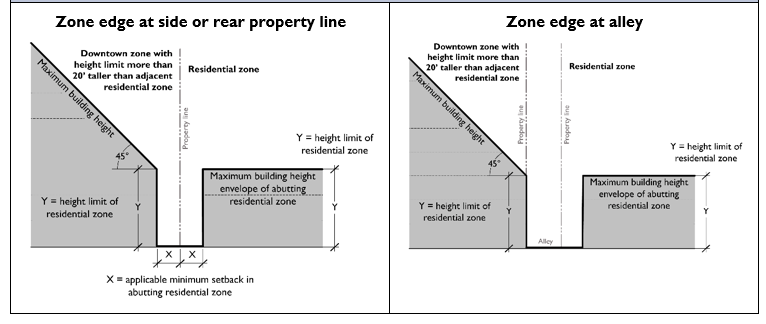
(4) Light and Air Access and Privacy Near Interior Side and Rear Property Lines. Buildings or portions thereof containing multifamily dwelling units whose only solar access (windows) is from the applicable side or rear of the building (facing towards the side or rear property line) shall be set back from the applicable side or rear property lines at least 15 feet. See Figure 22C.080.150(3). For building elevations taller than four stories, floors above the fourth floor shall be set back at least 20 feet from the applicable side or rear property lines. Note: These standards do not apply to side or rear property lines where adjacent to a street, access corridor, or easement where no building may be developed.
DEPARTURES will be allowed where it is determined that the proposed design will not create a compatibility problem in the near and long term based on the unique site context.
Figure 22C.080.150(3)
Light/air access and privacy standards for multifamily residential buildings along side and rear property lines.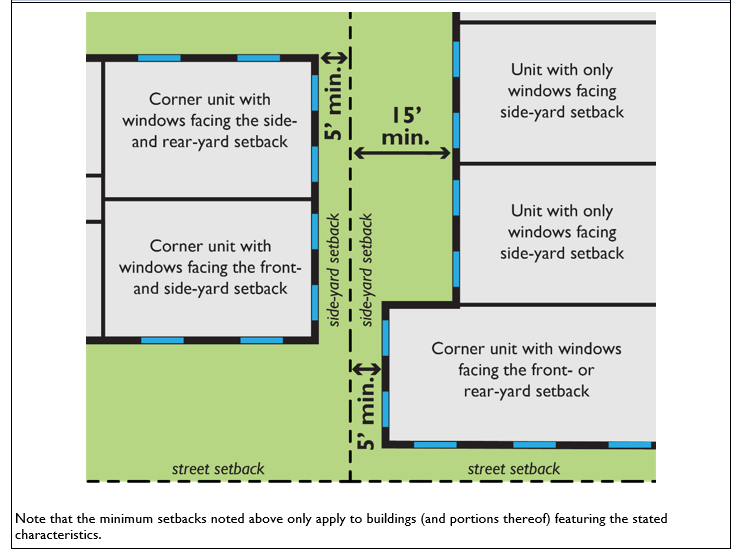
(Ord. 3295 § 10 (Exh. J), 2023; Ord. 3191 § 6 (Exh. B), 2021. Formerly 22C.080.410).
Article III. Street Design, Circulation and Parking
22C.080.200 Purpose.
The purpose of Article III is to:
(1) Expand and enhance downtown Marysville’s circulation network and streetscape design that support the envisioned pedestrian-friendly mixed use development within the subarea.
(2) Emphasize a “complete streets” approach to street improvements within downtown Marysville. This involves designing and operating streets to enable safe and convenient access and travel for all users including pedestrians, bicyclists, transit riders, and people of all ages and abilities, as well as freight and motor vehicle drivers, and to foster a sense of place in the public realm with attractive design amenities.
(3) Clarify the nature, extent, and location of required street and circulation improvements. (Ord. 3295 § 10 (Exh. J), 2023; Ord. 3191 § 6 (Exh. B), 2021).
22C.080.210 Streetscape classifications and regulations.
Downtown Marysville streetscape classifications and regulations are set forth in Chapter 3 of the Engineering Design and Development Standards. (Ord. 3295 § 10 (Exh. J), 2023; Ord. 3191 § 6 (Exh. B), 2021).
22C.080.220 Through-block connections.
Figure 22C.080.220(1) illustrates the configuration of several “through-block connections” intended to enhance pedestrian circulation in the area, while also providing an option for vehicular access to on-site parking, functioning as a design amenity to new development, and breaking up the massing of buildings on long blocks. Specific regulations:
(1) Required Connections and Public Access Easement. If an applicant owns a lot containing a proposed through-block connection, within it or along the edge of the property, the applicant shall provide such through-block connections in conjunction with their project development as a public right-of-way, or public access easement, as approved by the city engineer. Exception: For uses that require large building footprints, restricted security access, or other unique requirements for restricting access, the director may approve alternatives to designated through-block connections provided the proposed design maximizes pedestrian and vehicular connectivity on and/or around the site and the designs maximize opportunities for connectivity and contribution to a network.
Figure 22C.080.220(1)
Downtown Marysville planned through-block connections.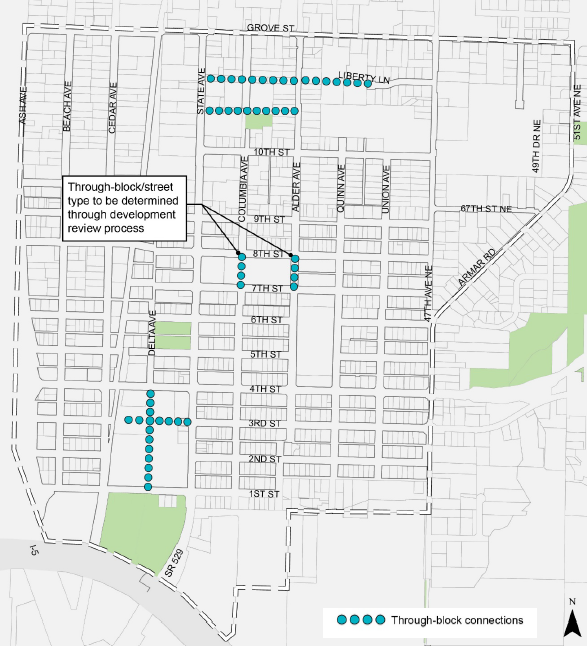
(2) Alignment. Specific alignments for the through-block connections will be developed during the development review process for applicable sites.
(3) Accessibility. Through-block connections shall be accessible to the public at all times and may take a variety of forms, depending on the block size and use mix, as specified in subsection (6) of this section.
(4) Design Departures. Adjustments to the through-block connection regulations in subsection (6) of this section may be approved by the city as a departure, pursuant to MMC 22C.080.030, provided the design:
(a) Creates a safe and welcoming pedestrian route.
(b) Provides an effective transition between the shared lane or path and adjacent uses (e.g., enhances privacy to any adjacent ground-level residential units).
(c) Functions as a design amenity to the development.
(5) Cantilever Design. Buildings may project or cantilever into minimum required easement areas on building levels above the connection provided a 13-foot, six-inch vertical clearance is maintained or as otherwise required for emergency access.
(6) Through-Block Connection Types. Unless otherwise noted in Figure 22C.080.305, required through-block connections may take any of the following forms. A combination of designs set forth above may be used for each connection.
(a) Street. Functions like a public street and features traditional curb and gutters.
(i) Applicability. The “street” design is required for the Columbia Avenue through-block connection and may be applied to any through-block connection within the subarea, as determined by the city engineer.
(ii) Roadway improvements, channelization, site access and lighting plans shall be required to be reviewed and approved by the city engineer.
(b) Woonerf Design. A “woonerf” is a shared lane where both vehicles and pedestrians share the space.
(i) Applicability. The “woonerf” or shared lane may apply to any through-block connection within the subarea.
(ii) Forty-foot minimum public access easement.
(iii) Twenty-foot-wide two-way shared travel lane featuring concrete, unit paving, or other similar decorative and durable surface material. Asphalt is prohibited.
(iv) Ten-foot minimum landscaping strips with L3 landscaping per MMC 22C.120.110 on each side of the shared lane. Curbs and/or raised planter walls may be included in the required landscaping area.
(v) Where such through-block connection is integrated along the edge of a development, a minimum easement of 20 feet is required for the shared travel lane.
(vi) Woonerf design connections are subject to block frontage regulations in MMC 22C.080.355.
Figure 22C.080.220(6)(b)(i) illustrates the cross-section for minimum regulations for the woonerf design.
|
|
Figure 22C.080.220(6)(b)(ii) illustrates regulations for scenarios where a through-block connection is located on the edge of a site, where its development likely will be phased in as the adjacent properties redevelop.
|
|
|
The top image illustrates a scenario where a new development includes a required access corridor on the edge of the development site abutting an existing development. In this scenario, a minimum 20-foot easement shall be required and include a shared lane. The shared lane shall be designed to allow a future connection to the adjacent site. The bottom image illustrates a second phase where the adjacent property is redeveloped. An additional 20-foot easement will be required plus a connection shall be added (where necessary to provide access for on-site parking), but the remaining area shall be landscaped with L3 Landscaping (see MMC 22C.120.110). |
(c) Landscaped Passageway Design.
(i) Applicability. Optional design when vehicular access to the site is provided elsewhere on the site.
(ii) Thirty-foot-minimum public access easement.
(iii) Eight- to 16-foot walking path. Eight to 10-foot paths are appropriate in a residential context, whereas the wider path is more desirable where active ground level uses with outdoor seating/dining areas.
(iv) Seven- to 11-foot minimum landscaping strips (with L3 landscaping per MMC 22C.120.110) on each side of the walking path. Raised planter walls may be included in the required landscaping area.
(v) Where such through-block connection is integrated along the edge of a development, a minimum easement of 15 feet is required for the subject walking path and landscaping. Adjustments to the walking path and landscaping widths and configurations are allowed provided the design effectively balances the following objectives:
(A) Creates a safe and welcoming pedestrian route.
(B) Provides an effective transition between the walking path and adjacent uses (e.g., enhances privacy to any adjacent ground-level residential units).
(C) Functions as a design amenity to the development.
(vi) Landscaped passageway design connections are subject to block frontage regulations in MMC 22C.080.355.
Figure 22C.080.220(6)(c)
Cross-section of minimum regulations and examples of a pedestrian access corridor.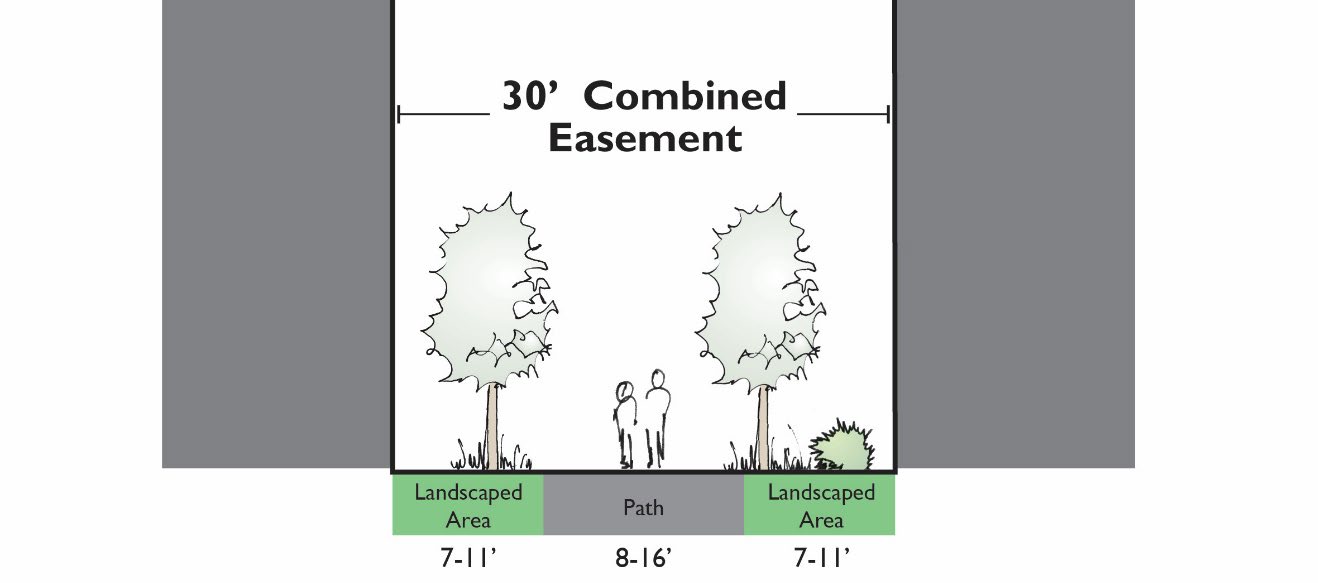
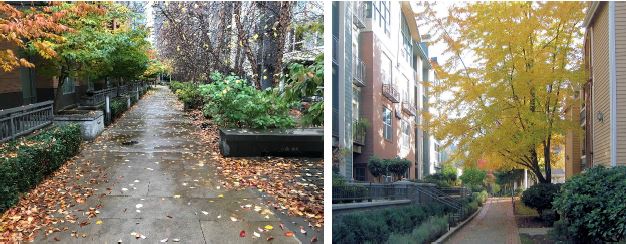
(d) Urban Passage Design.
(i) Applicability. Optional design when vehicular access to the site is provided elsewhere on the site and active ground-level uses are provided along frontages.
(ii) Sixteen-foot minimum public access easement.
(iii) Urban passage design connections are subject to block frontage regulations in MMC 22C.080.360.
Figure 22C.080.220(6)(d)
Urban passage examples.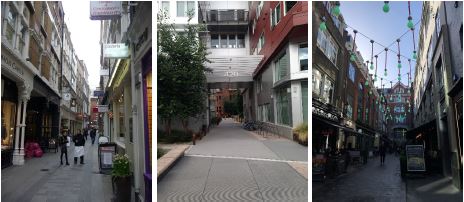
(Ord. 3295 § 10 (Exh. J), 2023; Ord. 3191 § 6 (Exh. B), 2021).
22C.080.230 Parking and loading.
The provisions herein supplement the off-street parking provisions in Chapter 22C.130 MMC, Parking and Loading. Where there is a conflict, the provisions herein apply.
(1) Tandem Parking. Tandem parking is allowed for individual dwelling units, and may be used to meet minimum parking standards.
(2) Minimum Number of Parking Spaces Required. The minimum number of parking spaces for all zones and use categories is stated in Table 22C.080.230.
(a) The number of parking spaces is computed based on the uses on the site. When there is more than one use on a site, the required parking for the site is the sum of the required parking for the individual uses. If the parking calculation used to determine parking requirements results in a fraction greater than or equal to one-half, parking shall be provided equal to the next highest whole number.
(b) Special cases are indicated by the term “director decision,” in which case parking requirements shall be established by the director. For determination by the director, the applicant shall supply one of the following:
(i) Documentation regarding actual parking demand for the proposed use.
(ii) Technical studies prepared by a qualified professional relating to the parking need for the proposed use.
(iii) Documentation of parking requirements for the proposed use from other comparable jurisdictions.
(iv) For unclassified uses, refer to MMC 22C.130.030(2)(i).
(c) Parking may be waived by the director for expansion of existing commercial uses requiring less than 10 spaces.
(d) For commercial uses requiring more than 10 spaces, the director may approve a 50 percent parking reduction if the applicant can demonstrate that adequate on-street parking facilities exist within 400 feet of the proposed use. In approving a parking reduction, the director may require improvement of existing, or dedicated, right-of-way to meet the intent of the downtown master plan by providing improved parking, walkways and access.
(e) Some developments within one-quarter mile of frequent transit may be eligible for a parking minimum exception or reduction per House Bill 1923, modified by House Bill 2343.
|
Use Categories |
Minimum number of off-street parking spaces |
Additional Provisions |
|---|---|---|
|
NONRESIDENTIAL (spaces per square feet of gross floor area, unless otherwise noted) |
||
|
Education services |
5 plus 1 per staff (elementary and junior high); 1 per 10 students plus 1 per staff (high school); and 1 per staff plus 1 per each 2 students (commercial/vocational schools) |
|
|
Eating and drinking establishments |
1/400 sf |
No parking is required for uses in a new building with less than 10,000 sf gross floor area in the Main Street (MS) zone |
|
Government services, general |
||
|
Health and social services |
||
|
Recreation, culture and entertainment, indoor |
||
|
Banks and professional office |
1/500 sf |
No parking is required for uses in a new building with less than 10,000 sf gross floor area in the Main Street (MS) zone |
|
Personal services use |
||
|
Retail uses |
||
|
Hotels and motels |
1/unit or suite |
|
|
General services, heavy services and heavy retail |
1/600 sf |
|
|
Artisan manufacturing |
1/750 sf |
|
|
Manufacturing, except artisan manufacturing |
1/1,000 sf |
Office areas are subject to the professional office space parking requirement |
|
Uses not otherwise categorized |
Director’s decision. |
|
|
RESIDENTIAL (spaces per dwelling unit) |
||
|
Single-family, duplex and townhome |
2.0 |
|
|
Accessory dwelling unit |
1.0 |
No parking is required within one-quarter mile of a major transit stop |
|
Multifamily dwelling unit |
|
|
|
Studio |
1.0 |
|
|
1 bedroom |
1.25 |
|
|
2 bedrooms or more |
1.5 |
|
(Ord. 3295 § 10 (Exh. J), 2023; Ord. 3191 § 6 (Exh. B), 2021).
Article IV. Design Standards – Block Frontages
22C.080.300 Purpose.
The purpose of Article IV is:
(1) To achieve the envisioned character of downtown Marysville as set forth in the goals and policies of the Marysville downtown master plan.
(2) To enhance pedestrian environments by emphasizing activated ground-level block frontage designs for commercial, mixed use, and multifamily developments.
(3) To minimize potential negative impacts of off-street parking facilities on the streetscape in strategic areas.
(4) To promote good visibility between buildings and the street for security for pedestrians and to create a more welcoming and interesting streetscape.
|
|
Permitted Frontage |
Details |
||||||||||
|---|---|---|---|---|---|---|---|---|---|---|---|---|
|
Active Ground Floor |
|
|
||||||||||
|
Pedestrian Friendly |
|
|
||||||||||
|
Landscaped |
|
|
||||||||||
|
Undesignated |
|
|
(Ord. 3295 § 10 (Exh. J), 2023; Ord. 3191 § 6 (Exh. B), 2021).
22C.080.305 Block frontage designation map.
(1) Application of Map and Block Frontage Standards. New development fronting on all streets in downtown Marysville is subject to applicable standards in this article based on the block frontage designation of the street.
(2) Sites with proposed new active ground floor or pedestrian friendly block frontage designations: New development shall integrate no less than 75 percent of the length of applicable active ground floor and/or pedestrian friendly block frontages illustrated in Figure 22C.080.305. The alignment of active ground floor and pedestrian-friendly block frontages may be adjusted during the development review process provided the configuration meets the goals and policies of the Marysville downtown master plan. For example, if a site includes approximately 100 lineal feet of an active ground floor designated block frontage and 200 lineal feet of pedestrian-friendly block frontage, the new development shall integrate at least 75 lineal feet of active ground floor block frontage compliant development and at least 150 lineal feet of pedestrian-friendly block frontage compliant development. Developments may exceed the amount of active ground floor and pedestrian-friendly block frontages illustrated in Figure 22C.080.305.
Figure 22C.080.305
Downtown Marysville block frontage designations map.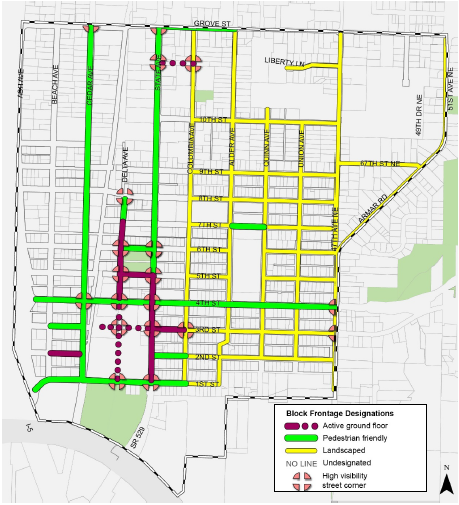
(Ord. 3295 § 10 (Exh. J), 2023; Ord. 3191 § 6 (Exh. B), 2021).
22C.080.310 Transparency standards.
Some block frontage designations contain distinct minimum facade transparency standards. The purpose of these standards is to maintain “eyes on the street” for safety and create welcoming pedestrian environments. Table 22C.080.310 includes details on how they are measured.
|
Transparency area |
|
|
|
|
|
Other transparency provisions |
|
|
Windows shall be transparent Ground-level window area for storefronts and other nonresidential uses that is covered, frosted, or perforated in any manner that obscures visibility into the building shall not count as transparent window area. Perforated signs are allowed provided they meet applicable window sign standards in MMC 22C.160.200. Also, mirrored glass and highly reflective or darkly tinted windows shall not be counted as transparent windows. |
|
|
Display windows and parking garages Display windows may be used for up to 25 percent of nonresidential transparency requirements (except for ground-level storefront-designated block frontages) provided they are at least 30 inches deep to allow changeable displays and the interior wall is nonstructural so it can be removed if the windows are not used for display. Tack-on display cases as shown in the far right example do not qualify as transparent window area. For parking garages (where allowed by block frontage standards), the left image illustrates how such a structure can meet (and not meet) the applicable transparency standards. |
|
(Ord. 3295 § 10 (Exh. J), 2023; Ord. 3191 § 6 (Exh. B), 2021).
22C.080.320 Active ground floor block frontage standards.
(1) Purpose. Active ground floor block frontages are the most vibrant and active shopping and dining areas within the subarea. Blocks designated as active ground floor block frontages (as shown in Figure 22C.080.305) include continuous storefronts placed along the sidewalk edge with small-scale shops and many business entries.
Figure 22C.080.320(1)
Active ground floor block frontage vision and key standards.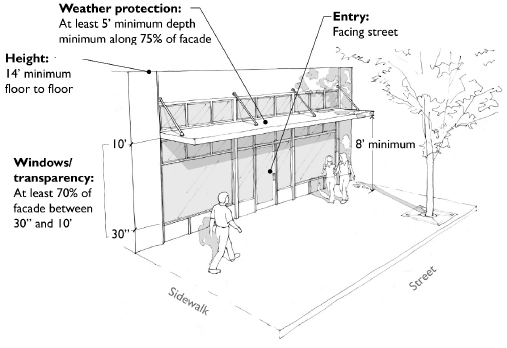
(2) Standards. All development on sites with an active ground floor block frontage designation shall comply with the standards in Table 22C.080.320(2):
|
The ➲ symbol refers to DEPARTURE opportunities. See MMC 22C.080.320(3) for special departure criteria. |
||||||||||||
|---|---|---|---|---|---|---|---|---|---|---|---|---|
|
Element |
Regulation |
Additional Provisions and Examples |
||||||||||
|
Ground level |
|
|
||||||||||
|
Land use |
Table 22C.080.120 sets forth the basic permitted uses in subarea zoning districts. However, only those uses listed below are permitted on the ground level on active ground floor block frontages:
|
Lobbies and accessory uses associated with upper-floor hotel/motel, business service, and multifamily residential uses are allowed provided they are limited to 33% of all active ground floor block frontages (measured separately for each block). |
||||||||||
|
Floor-to-ceiling height |
14' minimum (applies to new buildings only). |
Applies to the minimum retail space depth. |
||||||||||
|
Retail space depth |
50' minimum on 3rd Street and 30' elsewhere. ➲ |
|
||||||||||
|
Sidewalk width |
16' sidewalk (active ground-floor block frontage designation) 12' sidewalk (pedestrian-friendly block frontage designation where active ground-floor block frontage standards selected) |
Comfortable space for walking, outdoor dining, and street trees. For 16' sidewalks, the entire sidewalk must be in the public right-of-way. For 12' sidewalks, 8' of the sidewalk must be in the public right-of-way with the additional 4' of the sidewalk on private property within a public easement. |
||||||||||
|
Building placement |
Buildings shall be placed at the back edge of the required sidewalk. Additional setbacks are allowed for a widened sidewalk or pedestrian-oriented space (MMC 22C.080.430(4)). |
|
||||||||||
|
Building entrances |
Primary building entrances shall face the street. For corner buildings, primary entrances for ground-level building corner uses may face either street or the street corner. |
|||||||||||
|
Facade transparency (see MMC 22C.080.310) |
At least 75% of the transparency area. ➲ |
|
||||||||||
|
Weather protection |
Weather protection over the sidewalk is required along at least 75% of the storefront facade, and it shall be a minimum of 5' average depth and have 8' minimum vertical clearance. ➲ |
|
||||||||||
|
Weather protection shall not interfere with street trees, streetlights, street signs, or extend beyond the edge of the sidewalk. |
||||||||||||
|
Parking location |
New ground-level (surface or structured) parking adjacent to the street is prohibited. Parking may be placed below, above, beside, and/or behind storefronts. ➲ |
|
||||||||||
(3) DEPARTURE Criteria. Departures from the standards in Table 22C.080.320 that feature the ➲ symbol will be considered per MMC 22C.080.030 provided the alternative proposal meets the purpose of the standards and the following criteria:
(a) Retail Space Depth. Reduced depths of up to 25 percent of the applicable block frontage will be considered where the applicant can successfully demonstrate the proposed alternative design and configuration of the space is viable for a variety of permitted retail uses.
(b) Facade Transparency. The minimum percentage of facade transparency may be reduced by up to 40 percent if the facade design provides visual interest to the pedestrian and mitigates the impacts of blank walls.
(c) Weather Protection. The reduced extent (to no less than 50 percent of block frontages) or width of weather protection features (to no less than four feet in width) will be considered provided the designs are proportional to architectural features of the building and building design trade-offs (elements that clearly go beyond minimum building design standards in this chapter) meet the purpose of the standards. (Ord. 3295 § 10 (Exh. J), 2023; Ord. 3191 § 6 (Exh. B), 2021).
22C.080.330 Landscaped block-frontage standards.
(1) Purpose. Landscaped block frontages (as shown in Figure 22C.080.305) emphasize landscaped street setbacks, clear pedestrian connections between the building and the sidewalk, and minimized surface parking lots along the frontages.
Figure 22C.080.330(1)
Landscaped frontage vision.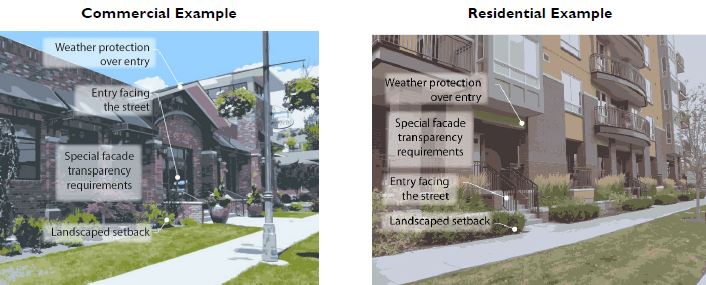
(2) Standards. All development on sites containing a landscaped block frontage designation shall comply with the standards in Table 22C.080.330(2). The standards herein also apply to all multifamily and nonresidential development in downtown residential zones:
|
The ➲ symbol refers to DEPARTURE opportunities. See MMC 22C.080.330(3) for special departure criteria. |
||||||
|---|---|---|---|---|---|---|
|
Element |
Regulation |
Additional Provisions and Examples |
||||
|
Ground level |
|
|
||||
|
Land use |
Table 22C.080.120 sets forth permitted land uses. |
|
||||
|
Sidewalk width |
Per applicable EDDS standard plan; however, properties with the pedestrian-friendly block frontage designation which select the landscaped block frontage standards shall provide an 8' sidewalk as outlined in Table 22C.080.340(2). |
|
||||
|
Building placement |
10' minimum setbacks are required ➲, except where greater setbacks are required by Table 22C.080.140. |
|
||||
|
Building entrances |
Building entries shall face the street or a pedestrian-oriented space (MMC 22C.080.430(4)) that is adjacent to the street. |
|
||||
|
Facade transparency (see MMC 22C.080.310) |
Transparent windows shall be provided along at least 15% of the entire building facade, plus:
|
|
||||
|
Weather protection |
Weather protection at least 3' deep shall be provided over individual residential and commercial tenant entries and at least 5' deep for shared residential, commercial, and professional office entries. |
Landscaped frontage example meeting setback, entry, weather protection, and transparency standards. |
||||
|
Parking location and driveways |
Ground-level parking shall not be visible from the street. Where parking is integrated at or near the ground level under the building, it shall be set back and completely screened by landscaped berms (upper right example). Drive-through lanes, for the purpose of block frontage standards, shall be considered a parking lot (and thus are not allowed between the street and a building). |
|
||||
|
|
The lower right example illustrates a prohibited design. Where alleys are available, vehicular access shall be taken from the alley. |
|
||||
|
Landscaping |
All areas between the sidewalk and the building shall be landscaped, except for pathways, porches, decks, and areas meeting the standards for pedestrian-oriented spaces (MMC 22C.080.430(4)). Landscaped areas shall contain L1, L2, L3 or L4 landscaping (as defined in MMC 22C.120.110) and may incorporate rain gardens and other forms of stormwater management. |
|
||||
(3) DEPARTURE Criteria. Departures to the pedestrian-friendly block frontage standards in Table 22C.080.330(2) that feature the ➲ symbol will be considered per MMC 22C.080.030 provided the alternative proposal meets the purpose of the standards and the following criteria:
(a) Building Placement. Reduced setbacks (down to a minimum of eight feet) will be considered where the ground floor is elevated a minimum average of 30 inches (required when the ground floor setback is less than 10 feet) and design treatments that create an effective transition between the public and private realm are incorporated. For example, a stoop design or other similar treatments that utilize a low fence or retaining wall, and/or hedge along the sidewalk may provide an effective transition (see Figure 22C.080.330(3) for examples).
(b) Facade Transparency. The minimum percentage of facade transparency may be reduced by up to 50 percent if the facade design provides visual interest to the pedestrian and mitigates the impacts of blank walls.
|
|
|
|
The apartment building (left image) includes a street setback of about six to eight feet and features a landscape planter, an elevated ground level, and generous window transparency. The elevated stoop frontages (right image) is another acceptable reduced setback departure example. The combination of landscaping elements, facade transparency, low fencing, and facade materials and detailing help to create an effective transition between the public and private realm. |
(Ord. 3295 § 10 (Exh. J), 2023; Ord. 3191 § 6 (Exh. B), 2021).
22C.080.340 Pedestrian-friendly block frontage standards.
(1) Purpose. Pedestrian-friendly block frontages (as shown in Figure 22C.080.305) allow flexibility to integrate either a storefront or a landscaped frontage in a pedestrian-friendly configuration.
Figure 22C.080.340(1)
Pedestrian-friendly frontage vision.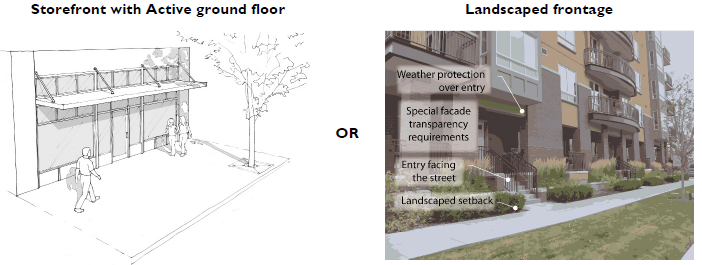
(2) Standards. Developments or portions thereof choosing to integrate a storefront design shall conform to active ground floor block frontage standards set forth in MMC 22C.080.320. Other frontage designs shall meet the landscaped block frontage standards set forth in MMC 22C.080.330, with only the following modifications in Table 22C.080.340(2):
|
The ➲ symbol refers to DEPARTURE opportunities. See MMC 22C.080.340(3) for special departure criteria. |
||||||
|---|---|---|---|---|---|---|
|
Element |
Regulation |
Additional Provisions and Examples |
||||
|
Sidewalk width |
8' or 12' sidewalk 8' sidewalk (pedestrian-friendly block frontage designation where landscaped block frontage standards selected) 12' sidewalk (pedestrian-friendly block frontage designation where active ground floor block frontage standards selected) |
8' of the sidewalk must be in the public right-of-way. When additional sidewalk width is required, it shall be on private property within a public easement. |
||||
|
Building placement |
Buildings may be placed up to the sidewalk edge provided they meet active ground floor block frontage standards in MMC 22C.080.320 (this includes standards for ground level, building placement, building entrances, facade transparency, and weather protection elements). The minimum setback for buildings that do not meet applicable active ground floor block frontage standards is 10' or greater where specified for the applicable zone in MMC 22C.080.140. ➲ |
Landscaped frontage example meeting setback, entry, weather protection, and transparency standards. |
||||
|
Facade transparency (see MMC 22C.080.310) |
Storefront buildings are subject to storefront block frontage transparency standards above. For other building frontages, transparent windows shall be provided along at least 15% of the entire building facade, plus:
|
|
||||
|
Parking location |
Parking shall be located to the side or rear of buildings. For sites with multiple buildings, no more than 50% of the block frontage shall be occupied by parking and vehicular access elements. Drive lanes between the street and building qualify as parking and vehicular access areas for the purpose of this standard. Where alleys are available, vehicular access shall be taken from the alley. |
|
||||
(3) DEPARTURE Criteria. Departures to the pedestrian-friendly block frontage standards in Table 22C.080.340(2) that feature the ➲ symbol will be considered per MMC 22C.080.030 provided the alternative proposal meets the purpose of the standards and the following criteria:
(a) Building Placement. Reduced setbacks (down to a minimum of eight feet) will be considered where the ground floor is elevated a minimum average of 30 inches (required when the ground floor setback is less than 10 feet) and design treatments that create an effective transition between the public and private realm. For example, a stoop design or other similar treatments that utilize a low fence or retaining wall, and/or hedge along the sidewalk may provide an effective transition (see Figure 22C.080.340(3) for examples).
(b) Facade Transparency. The minimum percentage of facade transparency may be reduced by up to 50 percent if the facade design provides visual interest to the pedestrian and mitigates the impacts of blank walls..
|
|
|
The apartment building (left image) includes a street setback of about six to eight feet and features a landscape planter, an elevated ground level, and generous window transparency. The elevated stoop frontages (right image) is another acceptable reduced setback departure example. The combination of landscaping elements, facade transparency, low fencing, and facade materials and detailing help to create an effective transition between the public and private realm. |
(Ord. 3295 § 10 (Exh. J), 2023; Ord. 3191 § 6 (Exh. B), 2021).
22C.080.350 Undesignated (streets with no designated block frontage).
(1) Purpose. Undesignated block frontages (as shown in Figure 22C.080.305) should provide visual interest at all observable scales and meet the design objectives for the subarea.
(2) Applicability. All undesignated block frontages are subject to the standards of this section. These block frontages are provided greater flexibility with regard to the design of development frontages.
These block frontages include a combination of side streets (where most uses often front on other adjacent streets) or other streets where greater flexibility in the frontage standards is desired. While there is greater flexibility in the amount of transparency of facades, and the location of surface and structured parking, design parameters are included to ensure that landscaping and other design elements help to mitigate the potential impacts of parking lots and blank walls along these streets.
DEPARTURES will be considered pursuant to MMC 22C.080.030.
(3) Standards. Undesignated block frontages shall comply with the standards in Table 22C.080.350(3).
|
Element |
Standards |
||||
|---|---|---|---|---|---|
|
Building placement |
Buildings may be placed up to the sidewalk edge within downtown core, Main Street, and flex zones, provided they meet the active ground floor block standards in MMC 22C.080.320 (this includes standards for ground level, building placement, building entrances, facade transparency, and weather protection elements). Otherwise, buildings shall be placed at least 15' behind the sidewalk. |
||||
|
Building entrances |
Building entrances facing the street are encouraged. At a minimum, at least one building entry visible and directly accessible from the street is required. Where buildings are set back from the street, pedestrian connections are required from the sidewalk. |
||||
|
Facade transparency (see MMC 22C.080.310) |
Transparent windows shall be provided along at least 10% of the entire building facade, plus:
DEPARTURE Standards and Criteria. The minimum percentage of facade transparency may be reduced by up to 50 percent if the facade design provides visual interest to the pedestrian and mitigates the impacts of blank walls. |
||||
|
Weather protection |
At least 3' deep over primary business and residential entries and at least 5' deep for shared entries for office and multifamily buildings. |
||||
|
Parking location and vehicle access |
There are no parking lot location restrictions, except for required landscaping buffers in Chapter 22C.120 MMC. |
||||
|
Landscaping |
|
(Ord. 3295 § 10 (Exh. J), 2023; Ord. 3191 § 6 (Exh. B), 2021).
22C.080.355 Woonerf and landscaped passageway frontage standards.
(1) Applicability. These standards apply to those block frontages along through-block connections designed with woonerf and landscaped passageway designs as set forth in MMC 22C.080.220. Exception: Those through-block connections with other applied block frontage designations.
(2) Purpose. Woonerf and landscaped passageway frontage standards provide eyes-on-the-pathway to create a safe and welcoming through-block connection while preserving the privacy of any adjacent ground-level residential units.
(3) Standards.
(a) Building elevations facing a woonerf or landscaped passageway through-block connection shall feature at least 10 percent window transparency. ➲
(b) Where ground-level residential uses are within five feet of a shared lane or pathway, at least one of the following design features shall be integrated to enhance the safety and privacy of adjacent residential units:
(i) Windows shall be placed at least six vertical feet above the access corridor.
(ii) A combination of landscaping, planter walls, and/or elevated ground floor (at least one foot above access corridor grade) that meets the purpose of the standards.
(c) Where nonresidential ground-level uses abut an access corridor, at least 25 percent of the applicable building elevation between four and eight feet above the ground-floor surface elevation shall be transparent. ➲
(d) Weather protection at least three feet deep shall be provided over individual residential and commercial tenant entries and at least five feet deep for shared residential and professional office entries facing the subject through-block connection. Exception: For residential uses, weather protection is required only for the unit’s primary entrance.
Figure 22C.080.355
Woonerf and landscaped passageway frontage design examples.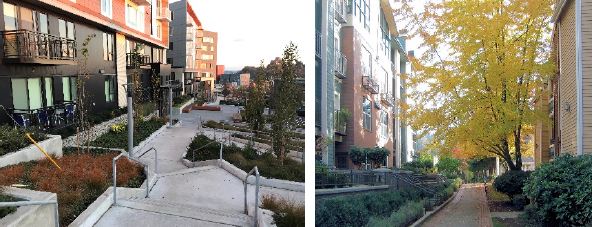
(Ord. 3295 § 10 (Exh. J), 2023; Ord. 3191 § 6 (Exh. B), 2021).
22C.080.360 Urban passage frontage standards.
(1) Applicability. These standards apply to those block frontages along through-block connections designed with urban passage designs.
(2) Purpose. To promote the development of pedestrian-friendly passages lined with active uses.
(3) Standards.
(a) Dwelling units and surface/ground-level parking directly adjacent to an urban passage are prohibited (lobbies and common/amenity areas, however, are allowed).
(b) Ground-level building elevations facing an urban passage through-block connection shall feature at least 40 percent window transparency (applied to storefront transparency area per MMC 22C.080.310). ➲
(c) Weather protection at least three feet deep shall be provided over individual commercial tenant entries and at least five feet deep for shared residential and professional office entries facing the subject through-block connection. Recessed entries are encouraged.
Figure 22C.080.360
Urban passage frontage examples.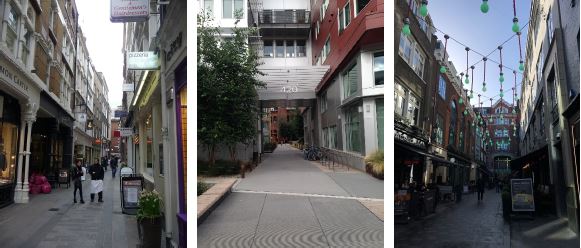
(Ord. 3295 § 10 (Exh. J), 2023; Ord. 3191 § 6 (Exh. B), 2021).
22C.080.370 Where properties front onto multiple streets.
Where a property fronts onto more than one street, each building frontage shall comply with the standards for the block frontage upon which it fronts, with the following clarifications:
(1) Where a conflict exists between frontage standards, the director will apply the standards of a block frontage pursuant to the following order of preference:
(a) Active ground floor;
(b) Pedestrian-friendly;
(c) Landscaped; then
(d) Undesignated.
Subsections (2) and (3) of this section clarify how the order of preference works for particular frontage elements.
(2) Entrances. For corner sites, entrances on both streets are encouraged, but only one entrance is required. For corner sites with frontage on a primary block frontage on one side, an entrance shall be placed on the primary block frontage side or facing the corner. For corner sites with a mix of designations that do not include a primary block frontage, the entry shall be placed in the order of preference identified in subsection (1) of this section.
DEPARTURES may be considered provided the location and design of the entry and block frontage treatments are compatible with the character of the area and enhance the character of the street.
(3) Transparency. For corner sites, at least one block frontage shall meet the applicable transparency standards (based on the order of preference above). For the second block frontage, the director may approve a reduction in the minimum amount of transparency by 50 percent. For street corners with the same designations on both frontages, buildings shall employ the full transparency on the dominant frontage (based on the frontage width or established neighborhood pattern). (Ord. 3295 § 10 (Exh. J), 2023; Ord. 3191 § 6 (Exh. B), 2021).
22C.080.380 High-visibility street corners.
(1) Description/Purpose. The high-visibility street corner requirements apply to those sites designated as such in Figure 22C.080.305. The purpose is to accentuate designated street corners with high visibility to the public.
(2) Standards. At least one of the following special features shall be included (Figure 22C.080.380(2) illustrates acceptable examples):
(a) Corner plaza.
(b) Cropped building corner with a special entry feature.
(c) Decorative use of building materials at the corner.
(d) Distinctive facade massing or articulation.
(e) Sculptural architectural element.
(f) Other decorative elements that meet the purpose of the standards.
|
|
|
|
|
The circled number or numbers on each image correspond to the numbered list of design features above. |
(Ord. 3295 § 10 (Exh. J), 2023; Ord. 3191 § 6 (Exh. B), 2021).
Article V. Design Standards – Site Planning
22C.080.400 Purpose.
The purpose of Article V is to:
(1) Promote thoughtful layout of buildings, parking areas, and circulation, service, landscaping, and amenity elements.
(2) Enhance downtown Marysville’s visual character.
(3) Promote compatibility between developments and uses.
(4) Integrate usable open space into new developments.
(5) Enhance the function and resilience of developments. (Ord. 3295 § 10 (Exh. J), 2023; Ord. 3191 § 6 (Exh. B), 2021).
22C.080.410 On-site open space and recreation space.
(1) Purpose.
(a) To create usable open space that is suitable for leisure or recreational activities for residents.
(b) To create open space that contributes to the residential setting.
(2) Applicability. Residential open space meeting the standards of this section is required for all new:
(a) Multifamily development.
(b) Mixed use development with residential units.
(c) Senior housing and other age-restricted facilities.
(d) Townhouses; provided, that only subsections (3)(b) and (5)(c) and (d) of this section and the applicable provisions in Table 22C.080.410 shall apply.
(3) Amount Required. Applicable developments shall be required to provide residential open space equal to a minimum of:
(a) One hundred square feet per dwelling unit for studio and one-bedroom dwellings.
(b) One hundred fifty square feet per multifamily dwelling unit for dwellings with two or more bedrooms, or per townhouse dwelling unit.
(4) Types.
(a) The following table illustrates the types of residential open spaces that may be used to meet the requirements in subsections (2) and (3) of this section:
|
Residential open space type |
Percentage of required open space |
Cross-reference to applicable design standards |
|---|---|---|
|
Common internal open space |
Up to 100% |
22C.080.410(5)(a) |
|
Common rooftop decks |
Up to 50% |
22C.080.410(5)(b) |
|
Private ground-level open space (applicable only to adjacent dwelling units) |
Up to 100% |
22C.080.410(5)(c) |
|
Private balconies |
Up to 25% |
22C.080.410(5)(d) |
|
Shared indoor recreation areas |
Up to 25% |
22C.080.410(5)(e) |
|
Children’s play areas |
Required for developments with greater than 50 units |
22C.080.410(5)(f) |
|
Note: Townhouses shall only be subject to the private ground-level open space and private balcony standards outlined in this table unless the applicant elects to substitute up to 50 percent of each unit’s private open space on a square-foot per square-foot basis with common open space. |
||
(b) Large Multiphase Developments Under Single Ownership. Each phase of development shall meet the minimum residential open space requirements herein. Developments have the option to integrate a surplus of usable on-site open space in early phases and apply the surplus space towards meeting the requirements for subsequent phases, provided all applicable standards are met.
(5) Residential Open Space Design Standards.
(a) Common Internal Open Space. “Common internal open space” refers to spaces that are internal to a development and accessible to all tenants of a development, but may not be accessible to the general public. Exception: For mixed use buildings with commercial and residential uses, the common internal open spaces only need to be accessible to all dwelling units within the building. Common internal open spaces can include landscaped courtyards or decks, terraces, entrance plazas, gardens with pathways, children’s play areas, pools, and water features. Accessible areas with native vegetation and areas used for storm water retention, infiltration, or other multipurpose recreational and/or green spaces that meet the design criteria herein may qualify as common internal open space.
Common Internal Open Space Design Standards.
(i) The space shall be accessible to all residents of the development.
(ii) Common internal open space shall be located in accessible areas that are visible from one or more units within the development.
(iii) Required setback areas shall not count as common internal open space unless the design of the space meets the standards herein.
(iv) Common internal open space shall feature no dimension less than 15 feet in order to provide functional leisure or recreational activity (unless otherwise noted herein). Wider minimum dimensions are required perpendicular to building elevations containing windows of dwelling units whose only solar access is from the applicable building wall. Specifically:
(A) Twenty feet minimum dimension for such elevations up to three stories tall.
(B) Twenty-five feet minimum dimension for such elevations four stories tall.
(C) Thirty feet minimum dimension for such elevations five or more stories tall.
|
|
20 feet minimum for such elevations up to three stories tall. |
|
|
25 feet minimum for such elevations four stories tall. |
|
|
30 feet minimum for such elevations five or more stories tall. |
(v) Common internal open space shall feature paths or walkable lawns, landscaping, seating, lighting, and play structures, sports courts, or other pedestrian amenities to make the area more functional and enjoyable for a range of users.
(vi) Common internal open space shall be separated from ground level windows, streets, service areas and parking lots with landscaping, fencing, and/or other acceptable treatments that enhance safety and privacy for both the common internal open space and dwelling units.
(vii) When possible, the space should be oriented to receive sunlight, face east, west or preferably south.
(viii) Stairways and service elements located within or on the edge of common internal open space shall not be included in the open space calculations.
(ix) Shared porches may qualify as common internal open space provided they are at least eight feet in depth and 96 square feet in total area.
(x) Stormwater management elements and LID BMPs, like rain gardens, may be integrated into the design of the space and may occupy up to 25 percent of the minimum required space. Where multiple common internal open spaces are included within a development, this standard applies to all such space combined, to allow flexibility in the design of individual spaces.
(xi) Any children’s play areas integrated as a part of a common internal open space shall meet the standards of subsection (5)(f) of this section.
|
|
|
Image A includes a combination of open lawn area for informal recreation plus pathways and decorative landscape areas to enhance the setting for residents. Image B is a courtyard which includes pathways, seating areas, landscaped beds, and semiprivate spaces for adjacent ground-level units. Image C includes a covered gathering space with outdoor grills adjacent to a landscaped commons with a central pathway. Image D includes a landscaped plaza with multiple seating areas and an outdoor fireplace. Courtyards with shared pools as in Image E are acceptable. Image F includes a common green area and separate fenced off-leash dog area. |
(b) Common Rooftop Decks. Such spaces are a type of common internal open space located on the top of buildings or intermediate levels (e.g., upper-floor building facade stepback areas) and are available to all residents. Examples of amenities include cooking and dining areas, seating areas, gardening areas, water features, and pet play areas. Design standards:
(i) The space shall be accessible to all residents of the development. Rooftop decks in mixed use buildings shall not be accessible to commercial tenants, employees, or customers (separate rooftop decks for commercial use are allowed but do not count as a residential open space).
(ii) Space shall feature hard surfacing and provide amenities such as weather protection elements, gas firepits, seating areas, and other features that encourage year-round use.
(iii) Space shall integrate landscaping elements that enhance the character of the space and encourage its use.
(iv) Space shall incorporate features that provide for the safety of residents, such as enclosures, railings, and appropriate lighting levels.
(v) Space shall feature no dimension less than 15 feet in order to provide functional leisure or recreational activity (unless otherwise noted herein).
(vi) When possible, the space should be oriented to receive sunlight, face east, west or preferably south.
(vii) Stairways and service elements located within or on the edge of common rooftop decks shall not be included in the open space calculations.
(viii) Any children’s play areas integrated as a part of a common rooftop deck shall meet the standards of subsection (5)(f) of this section.
Figure 22C.080.410(5)(b)
Common rooftop deck examples.
(c) Private Ground-Level Open Space. This space is adjacent and directly accessible to the subject unit. Examples include yards, stoops, and porches. Design standards:
(i) Such open spaces shall be enclosed by a fence and/or hedge at least 32 inches in height to qualify, but no higher than 42 inches when adjacent to a street, through-block connection, or publicly accessible area such as a public park or plaza.
(ii) Private unenclosed covered porches that face a street or a publicly accessible common area may qualify as open space provided they are at least 54 square feet in area, with no dimension less than six feet.
(iii) Ground-level private open space in excess of minimum requirements in subsection (5)(c)(ii) of this section shall not be used in the calculations for determining the minimum usable open space requirements for other units in the development per subsection (3) of this section.
Figure 22C.080.410(5)(c)
Private ground-level outdoor space examples.
(d) Private Balconies. This space is adjacent and directly accessible to the subject unit. Design standards for private balconies are the following:
(i) Private balconies in mixed use, multifamily developments should be at least partially recessed into the building facade, when provided, and integrated into the building design to provide protection from the weather.
(ii) Balconies shall be at least 36 square feet in area with no dimension less than six feet to qualify as open space.
(iii) Individual balconies in excess of minimum requirements in subsection (5)(d)(ii) of this section shall not be used in the calculations for determining the minimum usable open space requirements for other units in the development per subsection (3) of this section.
Figure 22C.080.410(5)(d)
Private balcony examples.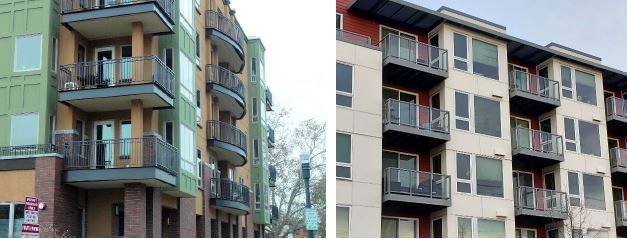
(e) Common Indoor Recreation Areas. Examples include multipurpose entertainment space, fitness center, movie theatre, kitchen, library, workshop, conference room, or similar amenities that promote shared use and a sense of community. Design standards for common indoor recreation areas are the following:
(i) The space shall be accessible to all residents of the development.
(ii) The space shall be located in a visible area, such as near an entrance, lobby, elevator bank, or high-traffic corridors.
(iii) Space shall be designed specifically to serve interior recreational functions and not merely be leftover unrentable space used to meet the open space requirement. Such space shall include amenities and design elements that will encourage use by residents.
(iv) Common indoor recreation areas may qualify as private internal common area provided they are at least 250 square feet in area.
Figure 22C.080.410(5)(e)
Common indoor recreation area examples.
(f) Children’s Play Areas. Any children’s play areas integrated as a part of a publicly accessible or common internal open space shall meet all the following (in addition to the design criteria listed above):
(i) Required children’s play areas shall be at least 400 square feet.
(ii) Measures necessary to protect children’s safety from vehicular traffic shall be included, such as low fencing or landscaping to provide a physical barrier around the perimeter.
(iii) Shade and rest areas for supervision shall be provided through the use of deciduous landscaping, architectural elements, or other means.
(iv) Natural, creative play elements should be provided. For instance, ground slides from one level to another, tricycle tracks, swings hung from arbors or trees, paths that meander and are of varying materials and widths, water that can be manipulated, outdoor rooms made from landscape or rocks, and berms and hills.
(v) Play areas shall be designed for a variety of ages, activities, and motor skills.
(vi) Play areas shall be located in areas that are highly visible to residents. (Ord. 3295 § 10 (Exh. J), 2023; Ord. 3191 § 6 (Exh. B), 2021. Formerly 22C.080.420).
22C.080.420 Pedestrian-oriented spaces.
(1) Purpose.
(a) To require the thoughtful integration of pedestrian-oriented spaces into commercial and mixed use developments.
(b) To enhance the design character and livability of downtown by creating vibrant spaces that accommodate active and passive activities, such as dining, resting, people watching, and recreational activities.
(2) Applicability. The standards herein apply to developments in the downtown core zone for sites containing buildings with at least 10,000 square feet of nonresidential floor area.
(3) Required Size of Space. Provide pedestrian-oriented space equal to at least two percent of the development site and meeting the design requirements of subsections (4) and/or (5) of this section. The required area may be consolidated in a single space or multiple spaces.
Figure 22C.080.420(3)
Required size of pedestrian-oriented space.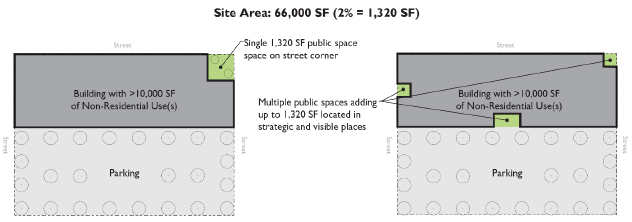
(4) Pedestrian-Oriented Space Design Standards.
(a) Required Features.
(i) The space shall abut a public sidewalk or other major internal pedestrian route and be designed to function as a focal point and gathering spot.
(ii) The space shall be ADA compliant and generally level with the adjacent sidewalk or internal pedestrian route. Steps, ramps and grade changes may be acceptable provided the outdoor space is designed to be visually and physically accessible from the adjacent sidewalk or internal pedestrian route and the space meets all other standards herein.
(iii) The space shall feature no dimension less than 15 feet in order to provide functional leisure or recreational activity. Exception: Portions of sidewalk area widened beyond minimum standards may qualify as pedestrian-oriented space provided storefronts abut the sidewalk.
(iv) The space shall be publicly accessible from 6:00 a.m. to 10:00 p.m.
(v) Large spaces (greater than 5,000 square feet) shall be designed to be multifunctional to accommodate a variety of uses and activities.
(vi) The space shall be framed on at least two sides by buildings that are oriented towards the space (via entries and generous facade transparency). Exception: Widened sidewalks that qualify as pedestrian-oriented space as set forth in subsection (4)(a)(iii) of this section only need to be framed on one side (by a storefront). Departures will be considered for unique configurations or designs that meet the purpose of the standards.
(vii) Paved walking surfaces of either concrete or approved unit paving are required. Form-in-place pervious concrete paving is allowed. Gravel surface areas may be allowed for special seating areas.
(viii) Except for natural areas or storm water infrastructure that contribute to the pedestrian environment, pedestrian amenities shall be integrated into the space. Examples include site furniture, artwork, drinking fountains, shade structures, kiosks, or other similar features that complement the space and encourage use of the space by a variety of users.
(ix) Lighting is required and integral to the design of the space for (A) safety and security, (B) intended activities or events, and (C) creating a distinct and inviting atmosphere. Lighting shall conform to MMC 22C.080.450.
(x) Except for natural areas or storm water infrastructure that contributes to the pedestrian environment (see subsection (4)(a)(xv) of this section), at least one individual seat per 30 square feet of plaza area or open space is required. At least 50 percent of the required seating shall be built-in seating elements, while provisions for moveable seating may be used for the remaining percentage. Two feet of seating area on a bench or ledge at least 16 inches deep at an appropriate seating height qualifies as an individual seat. Reductions of up to 50 percent will be allowed for the integration of specialized open spaces that meet the purpose of the standards herein.
(xi) Landscaping components that add visual interest and do not act as a visual barrier. This could include trees, planting beds, raised planters, and/or potted plants, or both.
(xii) Permanent weather protection along at least 50 percent of building edges (associated with nonresidential uses) at least six feet deep with horizontal clearance between eight and 15 feet.
(xiii) The space shall be proportional to the intended function and adjacent uses. For example, such spaces should not look or feel empty, barren, or too big when not in use.
(xiv) The space shall include design elements that appeal to the senses. Examples include the sound of water, the smell of plants, and/or the heat of fire. Sensory experiences may vary with the season, with water being present in the summer and a fire lit in the winter.
(xv) Storm water management elements and LID BMPs, like rain gardens, may be integrated into the design of the space and may occupy up to 25 percent of the required space. Where multiple publicly accessible open spaces are included within a development, this standard applies to all such space combined, to allow flexibility in the design of individual spaces.
(xvi) Rules of conduct similar to those for public parks may be posted.
(b) Prohibited Features.
(i) Large expanses of uninterrupted paving or paving without pattern.
(ii) Service and utility areas or venting of mechanical systems.
(iii) Long, narrow space with limited access.
(iv) Space providing vehicular access. Exception: Woonerf-style shared access lanes may be allowed (counted at 50 percent discount) provided through traffic is minimal and the design of access feature is well-integrated into the design of the larger space.
(v) Asphalt paving.
(vi) Adjacent chain-link fences.
(vii) Adjacent blank walls without blank wall treatment (MMC 22C.080.540).
(viii) Outdoor storage.
|
|
|
|
(Ord. 3295 § 10 (Exh. J), 2023; Ord. 3191 § 6 (Exh. B), 2021. Formerly 22C.080.430).
22C.080.430 Internal pedestrian access and design.
(1) Purpose.
(a) To improve the pedestrian and bicycling environment by making it easier, safer, and more comfortable to walk or ride among businesses, residences, to streets and sidewalks, to transit stops, and connections throughout the city.
(b) To enhance access to on- and off-site open space areas and pedestrian/bicycle paths.
(2) Access to Sidewalk. All buildings shall feature pedestrian connections to a sidewalk per applicable block frontage standards in Article IV of this chapter.
(3) Internal Circulation.
(a) For sites with multiple buildings, pedestrian paths connecting businesses and residential entries on the same development site shall be provided. Routes that minimize walking distances shall be utilized to the extent practical.
(b) Sites with Residential Units. Provide direct pedestrian access between all ground-related unit entries and a public street or to a clearly marked pathway network or open space that has direct access to a public street. Residential developments shall provide a pedestrian circulation network that connects all main entrances on the site to other areas of the site, such as:
(i) Parking areas.
(ii) Recreational areas.
(iii) Common outdoor spaces.
(iv) Any pedestrian amenities.
For townhouses or other residential units fronting the street, the sidewalk may be used to meet this standard. (Ord. 3295 § 10 (Exh. J), 2023; Ord. 3191 § 6 (Exh. B), 2021. Formerly 22C.080.440).
22C.080.440 Service areas and mechanical equipment.
(1) Purpose.
(a) To minimize adverse visual, odor, and noise impacts of mechanical equipment, utility cabinets and service areas at ground and roof levels.
(b) To provide adequate, durable, well-maintained, and accessible service and equipment areas.
(c) To protect residential uses and adjacent properties from impacts due to location and utilization of service areas.
(2) Location of Ground Related Service Areas and Mechanical Equipment. Service areas (loading docks, trash dumpsters, compactors, recycling areas, electrical panels, and mechanical equipment areas) shall be located for convenient service access while avoiding negative visual, auditory, olfactory, or physical impacts on the streetscape environment, pedestrian-oriented spaces, uses within the development, and adjacent residentially zoned properties. Specifically:
(a) Dumpsters shall be set back a minimum of five feet from side property lines, 10 feet from rear property lines (except when an alley is present) and 10 feet from front property lines; or be located to minimize visibility from any street, pedestrian walkway, or public park. Where the director finds that the only option for locating a service area is an area visible from a street, internal pathway or pedestrian area, or from an adjacent property, the area shall be screened with structural and landscaping screening measures provided in subsection (3) of this section.
(b) Dumpster storage areas shall be sized to accommodate the minimum dumpster sizes and necessary access (as required by the applicable utility provider) for garbage, recycling, and composting.
(3) Screening of Ground Related Service Areas and Mechanical Equipment. Service elements are encouraged to be integrated within the structure. Where they are not provided within the structure, the following standards apply:
(a) Where screening of ground-level service areas is required, the following applies:
(i) A structural enclosure shall be constructed of masonry, architectural concrete, heavy-gauge metal, or decay-resistant material that is also used with the architecture of the main building. The director may allow materials other than those used for the main building if the finishes are similar in color and texture or if the proposed enclosure materials are more durable than those for the main structure. The walls shall be sufficient to provide full screening from the affected roadway, pedestrian areas or adjacent use. The enclosure may use overlapping walls to screen dumpsters and other materials.
(ii) Gates shall be made of heavy-gauge, site-obscuring material. Chain link or chain link with slats is not an acceptable material for enclosures or gates.
(iii) Where the interior of a service enclosure is visible from surrounding buildings, an opaque or semi-opaque horizontal cover or screen shall be used to mitigate unsightly views. The horizontal screen/cover should be integrated into the enclosure design (in terms of materials and/or design). See Figure 22C.080.440(3) for examples.
(iv) Collection points shall be located and configured so that the enclosure gate swing does not obstruct pedestrian or vehicular traffic, or does not require that a hauling truck project into any public right-of-way. Ensure that screening elements allow for efficient service delivery and removal operations.
(v) The service area shall be paved.
|
Both enclosures include screening features on all sides, including above. Landscaping elements on the sides of the enclosures also help to mitigate the visual impacts. |
|
|
(b) The sides and rear of service enclosures shall be screened with landscaping at least five feet wide in locations visible from the street, parking lots, and pathways to soften views of the screening element and add visual interest.
DEPARTURES to the provisions of subsections (3)(a) and (b) of this section will be considered provided the enclosure and landscaping treatment meet the purpose of the standards and add visual interest to site users.
(c) Where loading docks are sited along block frontages (only allowed when no other reasonable options are available as determined by the director), they shall be designed to minimize impacts on the pedestrian environment. Standards:
(i) Configure loading docks/bays to minimize their frontage length along blocks.
(ii) Integrate architectural and/or landscaping design features to screen loading dock elements and add visual interest to pedestrians along adjacent sidewalks. See blank wall treatment provisions of MMC 22C.080.540 for standards and examples.
(4) Utility Meters, Electrical Conduit, and Other Service Utility Apparatus. These elements shall be located and/or designed to minimize their visibility to the public. Project designers are strongly encouraged to coordinate with applicable service providers early in the design process to determine the best approach in meeting these standards. If such elements are mounted in a location visible from the street, pedestrian pathway, shared open space, adjacent use, or shared auto courtyards, they shall be screened with vegetation and/or integrated into the building’s architecture.
|
Place utility meters in less visible locations. The lower left example is successfully tucked away in a less visible location and screened by vegetation. The right image is poorly executed and would not be permitted in such visible locations (along the sidewalk). Such meters shall be coordinated and better integrated with the architecture of the building. |
|
|
(5) Location and Screening of Roof-Mounted Mechanical Equipment.
(a) All rooftop mechanical equipment, including air conditioners, heaters, vents, and similar equipment, shall be effectively integrated (from design standpoint) or screened from public view both at grade and from nearby higher buildings with the exception of solar panels and roof-mounted wind turbines. Screening shall be located so as not to interfere with operation of the equipment.
(b) Rooftop mechanical equipment and associated screening features shall be set back from the exterior building walls by at least 10 feet. Exceptions may be made where the screening element is designed to help meet one or more building design standards in Article VI of this chapter.
(c) For rooftop equipment, all screening devices shall be well-integrated into the architectural design through such elements as parapet walls, false roofs, roof wells, clerestories, or equipment rooms. Screening walls or unit-mounted screening is allowed but less desirable. Wood shall not be used for screens or enclosures. Louvered designs are acceptable if consistent with building design style. Perforated metal is not permitted.
(d) The screening materials shall be of material requiring minimal maintenance and shall be as high as the equipment being screened.
(e) Locate and/or shield noise-producing mechanical equipment such as fans, heat pumps, etc., to minimize sounds and reduce impacts at property lines of adjacent properties.
|
|
|
The left illustration shows how rooftop mechanical equipment can be located and screened effectively. The right image shows effective location and screening, including side walls and a trellis to screen views from taller surrounding buildings. |
(Ord. 3295 § 10 (Exh. J), 2023; Ord. 3191 § 6 (Exh. B), 2021. Formerly 22C.080.450).
22C.080.450 Site lighting.
(1) Purpose.
(a) To ensure that lighting contributes to the character of the streetscape and does not disturb adjacent developments and residences.
(b) To protect against light pollution, thereby reclaiming the ability to view the night sky and helping to preserve the quality of life and scenic value of this desirable visual resource throughout the region and nearby natural open spaces.
(c) To help protect and enhance human health and wellness and wildlife habitation and migration by minimizing light pollution and its impact on all forms of life.
(d) To promote lighting practices and systems to conserve energy, decrease dependence on fossil fuels, and limit greenhouse gas emissions.
(e) To ensure that sufficient lighting can be provided where needed to promote safety and security on public and private property, and to allow for reasonable lighting for outdoor activities.
(f) To provide attractive lighting that supports and enhances the urban environment, emphasizes architectural elements, and encourages pedestrian activity and wayfinding beyond daylight hours, especially during the long nights of Pacific Northwest winters.
(2) Applicability. All outdoor lighting outside of public rights-of-way shall comply with the provisions herein. This includes, but is not limited to, new lighting, replacement lighting, additions and alterations, or any other lighting whether attached to buildings, poles, structures, the earth, or any other location.
(a) Exemptions.
(i) Lighting solely for signs.
(ii) Underwater lighting.
(iii) Temporary and seasonal cord-and-plug portable lighting.
(iv) Construction or emergency lighting.
(v) Outdoor rope and string lights for outdoor seating and gathering areas.
(3) General Standards. Exterior lighting shall be integrated as both a functional safety element and a design element that enhances the character and use of the site and building, while minimizing negative impacts on uses on and off the site.
(a) All luminaires shall be fully shielded and shall not emit light into the upper hemisphere around the luminaire or onto adjacent properties and structures, either through exterior full cut-off shields or through optics within the fixture. Support and mounting systems for luminaires shall not allow post-installation adjustments that could defeat compliance with this requirement.
(b) On-site lighting elements throughout and surrounding the site should be complementary, including pedestrian pathway, accent and parking lot lighting, lighting of adjacent developments and the public right-of-way.
(c) Except as provided in this section, outdoor lighting is encouraged to follow the intensity, technology, and other recommendations of the International Dark Sky Association and the Illuminating Engineering Society.
Figure 22C.080.450(3)
Examples of appropriate light shielding.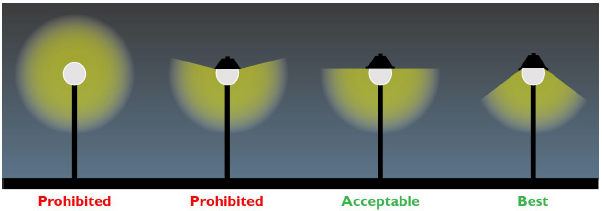
(4) Height.
(a) Freestanding lighting fixtures in parking lots shall not exceed 20 feet in height. Lighting fixtures on the top level of parking garages shall not exceed 12 feet in height.
(b) Pedestrian scale lighting shall not exceed 15 feet in height.
(c) Building-mounted exterior lighting shall not be placed at any point greater than 20 feet above the adjacent grade, except the height limit is 14 feet when within 100 feet of a single-family zone. This standard does not apply to fully recessed lights, such as when mounted on the underside of a gas station fueling canopy or building roof overhang.
Figure 22C.080.450(4)
Examples of site lighting.
(5) Lighting Levels.
(a) All public areas shall be lighted with average minimum and maximum levels as follows:
(i) Minimum (for low or nonpedestrian and vehicular traffic areas) of one-half foot candle.
(ii) Moderate (for moderate or high volume pedestrian areas) of one to two foot candles.
(iii) Maximum (for high volume pedestrian areas and building entries) of four foot candles.
(b) Lighting shall be provided at consistent levels, with gradual transitions between maximum and minimum levels of lighting and between lit areas and unlit areas. Highly contrasting pools of light and dark areas shall be avoided.
(c) Light levels at the property line should not exceed 0.1 foot candles (fc) adjacent to business properties, and 0.05 foot candles adjacent to residential properties.
(6) Parking Lot Lighting. Lighting parking lots shall be appropriate to create adequate visibility at night and evenly distributed to increase security. Lighting shall be located so that trees within the parking lot do not obscure the operation of the light fixture.
(7) Lighting Color (Chromaticity). The correlated color temperature of all outdoor lighting shall be 3,500 Kelvin maximum or lower (refer to American National Standards Institute’s publication C78.377 for guidance on LED lighting). Exceptions may be made for architectural floodlighting, accent lighting, or outlining.
Figure 22C.080.450(7)
Kelvin temperature chart.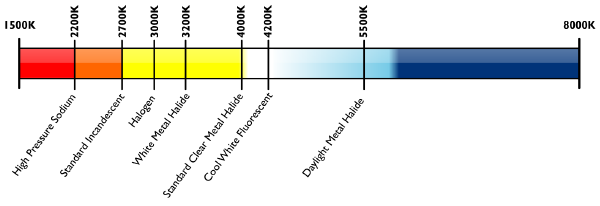
(8) Exterior Lighting Controls. Automated control systems, such as energy management systems, photoelectric switches, motion sensors and astronomic timer switches, shall be used to meet the hours of operation requirements and the technical and energy efficiency requirements of the applicable Washington State Energy Code. Exceptions:
(a) Egress lighting as required by the building code.
(b) Lighting required for accessibility.
(c) Lighting required by statute, law, or ordinance to operate all night.
(d) A manual override at each exit door is allowed regardless of automatic control device.
(e) Seasonal holiday lighting and event lighting.
(9) Prohibited Lighting.
(a) Dynamic lighting.
(b) Luminaires exceeding 500,000 peak candelas and/or 500,000 lumens.
(c) Laser lighting.
(d) Any lighting of critical areas.
(e) Any lighting that may be confused with warning signals, emergency signals, or traffic signals.
(f) Mercury, low pressure sodium, or other light sources in public areas that can impede or distort the perception of actual colors.
(g) Blinking, flashing, intermittent, and/or moving lights unless specifically allowed elsewhere in the Marysville Municipal Code.
(h) Lighting permanently attached to trees. (Ord. 3295 § 10 (Exh. J), 2023; Ord. 3191 § 6 (Exh. B), 2021. Formerly 22C.080.460).
Article VI. Design Standards – Building Design
22C.080.500 Purpose.
Article VI provides direction for the design of buildings consistent with the goals and policies of the downtown Marysville plan. See the individual “purpose” statements for each section in this chapter. (Ord. 3295 § 10 (Exh. J), 2023; Ord. 3191 § 6 (Exh. B), 2021).
22C.080.505 Third Street character area.
Special building design standards in this article apply to the three-block stretch of Third Street, between Alder Avenue and 47th Avenue NE to reinforce the area’s historic/traditional character:
(1) MMC 22C.080.510(2)(a)(ii), regarding facade articulation standards.
(2) MMC 22C.080.510(5), regarding pitched rooflines.
Figure 22C.080.505
Map of Third Street character area.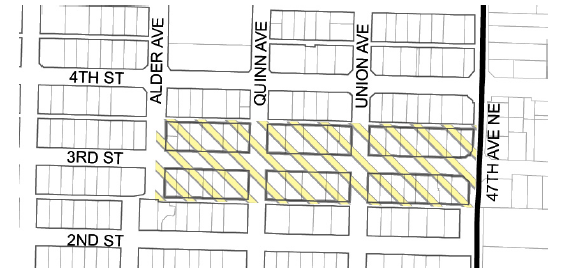
(Ord. 3295 § 10 (Exh. J), 2023; Ord. 3191 § 6 (Exh. B), 2021).
22C.080.510 Building massing and articulation.
(1) Purpose. To employ facade articulation techniques that reduce the perceived scale of large buildings and add visual interest from all observable scales.
(2) Facade Articulation. All applicable buildings shall include facade articulation features at maximum specified intervals to create a human-scaled pattern. These standards apply to building elevations facing streets (public and private), parks, zone edges, and through-block connections (except alley designs).
(a) Maximum Facade Articulation Intervals.
(i) Residential elevations: The width of the dwelling units inside the building (e.g., if the units are 25 feet wide, the facade articulation shall be 25 feet wide). This includes residential portions of mixed use buildings.
(ii) Third Street character area: 25 feet.
(iii) Storefronts: 30 feet. This refers to all ground-level elevations along active ground-floor designated block frontages.
(iv) Other ground-level elevations: 40 feet.
(v) Office buildings and other upper-level nonresidential elevations in the DC and flex zones: 60 feet.
(b) Articulation Features. At least three of the following articulation features shall be employed for all buildings in compliance with the maximum specified facade articulation intervals. Exception: Nonresidential buildings in the flex zone shall include at least two articulation features.
(i) Use of a window fenestration pattern.
(ii) Use of weather protection features.
(iii) Use of vertical piers/columns (applies to all floors of the facade, excluding upper level stepbacks).
(iv) Change in roofline per subsection (4) of this section.
(v) Change in building material and/or siding style (applies to all floors of the facade, excluding upper-level stepbacks).
(vi) Vertical elements such as a trellis with plants, green wall, art element that meet the purpose of the standard.
(vii) Providing vertical building modulation of at least 12 inches in depth if tied to a change in roofline per subsection (4) of this section or a change in building material, siding style, or color. Balconies may be used to qualify for this option if they are recessed or projected from the facade by at least 18 inches.
(viii) Other design techniques that effectively reinforce a pattern of articulated facades compatible with the building’s surrounding context.
DEPARTURES will be considered provided they meet the purpose of the standards and the design criteria below. For example, a departure may propose a design with only two articulation features instead of three and/or the articulation features exceed the maximum articulation interval.
|
|
|
Building A uses window patterns, horizontal building modulation, changes in building materials, and balconies to articulate the facade. Building B uses window patterns, vertical columns/piers, and weather protection features for the storefront level and window patterns, horizontal building modulation, and changes in building materials on upper residential floors. |
|
|
|
Flex zone/nonresidential building examples: Building C uses window/entry pattern and weather protection features. Building D uses window patterns, vertical columns, steel canopies, and material changes. |
(c) DEPARTURE Criteria Associated with Articulation Standards. Proposals shall meet the purpose of the standards. The following criteria will be considered in determining whether the proposed articulation treatment meets the purpose:
(i) Consider the type and width of the proposed articulation treatment and how effective it is in meeting the purpose given the building’s current and desired context (per Marysville downtown master plan).
(ii) Consider the applicable block frontage designation. Pedestrian-friendly or undesignated block frontages warrant more flexibility than active ground-floor block frontages.
(iii) Consider the size and width of the building. Smaller buildings (less than 120 feet wide) warrant greater flexibility than larger buildings.
(iv) Consider the quality of facade materials in concert with doors, windows, and other facade features and their ability to add visual interest to the street from a pedestrian scale and more distant observable scales.
(3) Maximum Facade Length. Building facades and other building elevations facing lower intensity residential zone edge shall include at least one of the following features to break up the massing of the building and add visual interest. This standard applies to building elevations longer than 120 feet in residential zones and the MS zone and 140 feet in the DC and flex zones.
(a) Provide vertical building modulation at least six feet deep and 15 feet long in the mixed use zones and at least eight feet deep and 20 feet long in the employment zones. For multistory buildings, the modulation shall extend through at least one-half of the building floors.
(b) Use of a contrasting vertical modulated design component featuring all of the following:
(i) Utilizes a change in building materials that effectively contrast from the rest of the facade.
(ii) Component is modulated vertically from the rest of the facade by an average of six inches.
(c) Facade employs building walls with contrasting articulation that make it appear like multiple distinct buildings. To qualify for this option, these contrasting facades shall employ all of the following:
(i) Different building materials and/or configuration of building materials.
(ii) Contrasting window design (sizes or configurations).
(d) DEPARTURES to subsections (3)(a) through (c) of this section will be considered provided the design meets the purpose of the standards. Supplemental consideration for approving alternative designs:
(i) Width of the facade. The larger the facade, the more substantial articulation/modulation features need to be.
(ii) Block frontage designation. Active ground-floor designated block frontages warrant the most scrutiny.
(iii) The type of articulation treatment and how effective it is in meeting the purpose given the building’s context.
|
|
|
|
Less than maximum facade length dimension |
Exceeds maximum facade length dimension |
|
|
|
|
Building incorporates a courtyard along the facade (technique No. 1 noted above) to effectively break it up into smaller components. Meets standard. |
|
|
|
|
|
The left building uses technique No. 1 (vertical building modulation at least six feet deep and 15 feet wide). The right building uses technique No. 2 (contrasting vertical modulated design component) together with different window fenestration designs on each side. Both examples are effective in breaking up the perceived scale of the building and adding visual interest. |
|
(4) Roofline Modulation. Roofline modulation is encouraged and it can be used as one of the facade articulation features in subsections (2) and (3) of this section. In order to qualify as an articulation feature, rooflines shall employ one or more of the following:
(a) For flat roofs or facades with horizontal eave, fascia, or parapet, the minimum vertical dimension of roofline modulation is the greater of two feet or 0.1 multiplied by the wall height (finish grade to top of the wall) when combined with vertical building modulation techniques described in subsections (2) and (3) of this section. Otherwise, the minimum vertical dimension of roofline modulation is the greater of four feet or 0.2 multiplied by the wall height.
(b) A pitched roofline or gabled roofline segment of at least 20 feet in width. Buildings with pitched roofs shall include a minimum slope of 5:12 and feature modulated roofline components at the interval required per the applicable standard above.
(c) A combination of the above.
DEPARTURES will be considered provided the roofline modulation design effectively reduces the perceived scale of the building and adds visual interest.
|
|
|
|
(5) Pitched Rooflines in the Third Street Character Area. Buildings in the Third Street character area shall employ gabled or hipped rooflines to reinforce the character and scale of the area.
Figure 22C.080.510(5)
Third Street character area – existing roofline examples.
(Ord. 3295 § 10 (Exh. J), 2023; Ord. 3191 § 6 (Exh. B), 2021).
22C.080.520 Building details.
(1) Purpose.
(a) To encourage the incorporation of design details and small-scale elements into building facades that are attractive at a pedestrian scale.
(b) To integrate window design that adds depth, richness, and visual interest to the facade.
(2) Facade Details – Nonresidential and Mixed Use Buildings. All building facades and other building elevations facing parks, pedestrian-oriented spaces, and containing primary building entrances shall be enhanced with appropriate details. All new buildings shall employ at least one detail element from each of the three categories below for each facade articulation interval (see MMC 22C.080.510(2)).
(a) Window and/or entry treatment, such as:
(i) Transom windows.
(ii) Roll-up windows/doors.
(iii) Recessed entry.
(iv) Decorative door.
(v) Other decorative or specially designed window, shading or entry treatment that meets the purpose of the standards.
|
|
|
A = openable storefront window. B = transom windows. C = openable window with decorative details. D = decorative window shades. E = decorative door. F = recessed entry. |
|
|
(b) Building elements and facade details, such as:
(i) Custom-designed weather protection element such as a steel canopy, glass, or retractable awning. Custom-designed cloth awnings may be counted as a detail provided they are constructed of durable, high-quality material.
(ii) Decorative building-mounted light fixtures.
(iii) Bay windows, trellises, towers, and similar elements.
(iv) Other details or elements that meet the purpose of these standards.
|
|
|
A = retractable awning; B = custom hanging bike rack and repair station integrated as a design element; C = decorative lighting fixtures; D = steel canopy; E = bay window; F = decorative corner tower. |
|
|
(c) Building materials and other facade elements, such as:
(i) Use of decorative building materials/use of building materials. Examples include decorative use of brick, tile, or stonework.
(ii) Decorative kickplate, pilaster, base panel, or other similar feature.
(iii) Hand-crafted material, such as special wrought iron or carved wood.
(iv) Other details that meet the purpose of the standards.
|
|
|
A and B = Decorative column/pier masonry/tile-work. C = Decorative emblem (not advertising a particular business). D = Decorative mosaic tilework at building entry. E = Decorative bulkhead design. F = Decorative column/pier brickwork. |
|
|
DEPARTURES for facade detail standards of this subsection (2) will be considered provided the facade (at the overall scale and at the individual articulation scale) meets the purpose of the standards.
(3) Window Design Standards. All windows shall employ designs that add depth and richness to the building facade. At least one of the following features shall be included to meet this requirement:
(a) Recess windows at least one and one-half inches from the facade.
(b) Incorporate window trim (at least three inches wide) around windows.
(c) Incorporate other design treatments that add depth, richness, and visual interest to the facade.
|
|
|
The windows in images A through C are recessed by at least one and one-half inches from the facade. Images D and E feature a reveal/recess of less than one and one-half inches, but the contrasting frames and mullions effectively add a sense of depth and richness to the facade. The treatment in image F does not effectively add a sense of depth and richness to the facade.
|
(4) Cornice/Roofline Design. Buildings employing a flat roof shall employ a distinctive roofline that effectively provides an identifiable “top” to the building. This could include a traditional cornice line or a contemporary interpretation of a traditional cornice line.
(a) Such rooflines shall be proportional to the size and scale of the building.
(b) Understated cornice lines are permitted depending on the materials and design of the base and middle elements in reinforcing the base/middle/top configuration.
Figure 22C.080.520(4)(b) illustrates acceptable and unacceptable examples.
|
|
|
Building A uses a dramatic overhanging cornice at the corner. Building B uses a simple glass railing and an upper level building stepback. |
|
|
|
Buildings C and D simply appear to end without any statement of confidence and do not meet the standard. |
Rooftop solar units are permitted, provided the placement and design of units visible from the surrounding streetscape are carefully integrated into the overall design concept of the building.
(5) Articulated Building Entries. The primary building entrance for an office building, hotel, apartment building, public or community-based facility or other multistory commercial building shall be designed as a clearly defined and demarcated standout architectural feature of the building. Such entrances shall be easily distinguishable from regular storefront entrances on the building. Such entries shall be scaled proportional to the building. See Figure 22C.080.520(5) for good examples.
|
|
(Ord. 3295 § 10 (Exh. J), 2023; Ord. 3191 § 6 (Exh. B), 2021).
22C.080.530 Building materials.
(1) Purpose.
(a) To encourage the use of durable, high quality, and urban building materials that minimize maintenance cost and provide visual interest from all observable vantage points.
(b) To promote the use of a distinctive mix of materials that helps to articulate facades and lends a sense of depth and richness to the buildings.
(c) To place the highest priority on the first floor in the quality and detailing of materials at the pedestrian scale.
(2) Special Conditions and Limitations for the Use of Certain Cladding Materials.
(a) Concrete block (a.k.a. concrete masonry unit or CMU) may be used as a secondary cladding material (no more than one-third of total facade cladding) on building elevations facing streets, parks, pedestrian-oriented spaces, and containing primary building entrances provided it is incorporated with other permitted materials.
DEPARTURES will be considered for alternative designs that use concrete block as the primary, but not the only, cladding material provided the design incorporates a combination of textures and/or colors to add visual interest. For example, combining split or rock-facade units with smooth blocks can create distinctive patterns. The figures below illustrate acceptable concrete block use/designs.
|
|
|
|
Building A uses smooth-faced CMU as a contrasting feature that helps to highlight the main building entry. The simple design helps to add emphasis to the doors, canopy and decorative sconce lights. |
Building B illustrates an acceptable departure example, as CMU is used as the primary cladding material. Note the use of beige split-facade CMUs above each of the awnings and coupled with the use of smooth-faced gray CMUs on the vertical columns (which employ black accent tiles for added interest). |
(b) Metal siding may be used on all building elevations provided it complies with the following standards:
(i) It shall feature visible corner molding and trim. Masonry, concrete, or other durable material shall be incorporated between the metal siding and the ground plane for all residential buildings and storefronts.
(ii) Metal siding shall be factory finished, with a matte, nonreflective surface.
DEPARTURES will be considered provided the material’s integration and overall facade composition meets the purpose of the standards.
|
|
|
Building A successfully uses metal siding more as an accent element to help articulate the facade. Metal is the primary material in the industrial building B, which includes distinct scoring patterns and refined window designs. Metal siding is integrated with other materials in buildings C and D, both of which integrate subtle changes in color to go with articulation features and design details. |
(c) Standards for the Use of Exterior Insulation and Finish System (EIFS). Such material/finishes may be used when it complies with the following:
(i) For residential buildings, EIFS is limited to no more than 50 percent of the cladding for building elevations facing streets, parks, pedestrian-oriented spaces, and containing primary building entrances of the total facade area.
(ii) For nonresidential and mixed use buildings, EIFS is limited to no more than 25 percent of the cladding for building elevations facing streets, parks, pedestrian-oriented spaces, and containing primary building entrances of the total facade area.
(iii) EIFS shall feature a smooth or sand finish only.
(iv) EIFS shall be trimmed in wood, masonry, or other material and shall be sheltered from weather by roof overhangs or other methods.
(v) EIFS shall not be used on the ground floor of facades containing nonresidential uses.
DEPARTURES will be considered provided the material’s integration and overall facade composition meets the purpose of the standards.
|
|
|
|
|
Buildings A and B mix EIFS with brick and other materials and integrate trim details around windows to add a sense of depth to the facade. Building C uses EIFS in between the window and sidewalk – this design is prohibited. Building D uses EIFS as the primary siding material, which is prohibited. |
(d) Cementitious wall board paneling/siding may be used on all building elevations provided it meets the following provisions:
(i) Cement board paneling/siding may not be used on ground-level facades containing nonresidential uses.
(ii) Where cement board paneling/siding is the dominant siding material, the design shall integrate a mix of colors and/or textures that are articulated consistent with windows, balconies, and modulated building surfaces and are balanced with facade details that add visual interest from the ground level and adjacent buildings.
DEPARTURES will be considered provided the material’s integration and overall facade composition meets the purpose of the standards.
|
|
|
Buildings A and B use cementitious wall board in different textures and colors (maroon and yellow elevations in building A and all elevations in building B) to help articulate the facades. |
|
|
|
Building C uses cementitious wall board to mimic horizontal wood siding (green elevation to the right). The white wall board panels covering a large area in building D would not meet the purpose of the standards. |
(Ord. 3295 § 10 (Exh. J), 2023; Ord. 3191 § 6 (Exh. B), 2021).
22C.080.540 Blank wall treatment.
(1) Purpose.
(a) To avoid untreated blank walls.
(b) To retain and enhance the character of downtown Marysville’s streetscapes.
(2) Blank Wall Definition. “Blank wall” means a ground-floor wall or portion of a ground-floor wall over 10 feet in height and a horizontal length greater than 15 feet and does not include a transparent window or door.
Figure 22C.080.540(2)
Blank wall definition.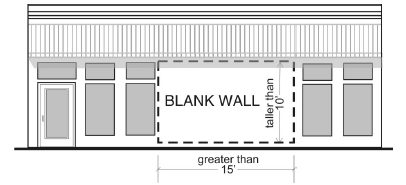
(3) Blank Wall Treatment Standards. Untreated blank walls adjacent to a public street, pedestrian-oriented space, common outdoor space, or pedestrian pathway are prohibited. Methods to treat blank walls can include:
(a) Display windows at least 16 inches in depth to allow for changeable displays. Tack-on display cases (see Figure 22C.080.540(3)) do not qualify as a blank wall treatment.
(b) Landscape planting bed at least five feet deep or a raised planter bed at least two feet high and three feet deep in front of the wall with planting materials that are sufficient to obscure or screen at least 60 percent of the wall’s surface within three years.
(c) Installing a vertical trellis in front of the wall with climbing vines or plant materials.
(d) Installing a mural as approved by the director. Commercial advertisements are not permitted on such murals.
(e) Special building detailing that adds visual interest at a pedestrian scale. Such detailing shall use a variety of surfaces; monotonous designs will not meet the purpose of the standards.
For large visible blank walls, a variety of treatments may be required to meet the purpose of the standards.
|
|
|
Buildings A through C all feature some form of landscaping to screen (Building A) or add visual interest to the building elevation. Building B uses a decorative mix of materials to provide visual interest, whereas Building C uses a metal sculpture to screen a large blank wall. The display cases in Building D don’t meet the 16-inch depth requirement, nor do they meet the purpose of the standards. |
(4) Firewalls. Firewalls along property lines are exempt from the above standards, but where they are visible to the public (from the adjacent street), they shall be designed to provide visual interest from all observable distances. Examples may include the use of varying materials, textures, and/or colors, the use of green or living walls, and/or the use of modulated building walls to form design patterns.
Murals are also encouraged as a firewall treatment. Murals are subject to approval by the director. Commercial advertisements are not permitted on such murals.
|
|
|
|
Building A uses a combination of paint bands and ivy to enhance the appearance of this large exposed firewall. Building B uses simple scoring patterns and change in materials and color on part of the top floor to add visual interest. |
|
|
|
Plain gray concrete block firewalls such as this in Building C are not allowed when visible from the street. |
(Ord. 3295 § 10 (Exh. J), 2023; Ord. 3191 § 6 (Exh. B), 2021).



